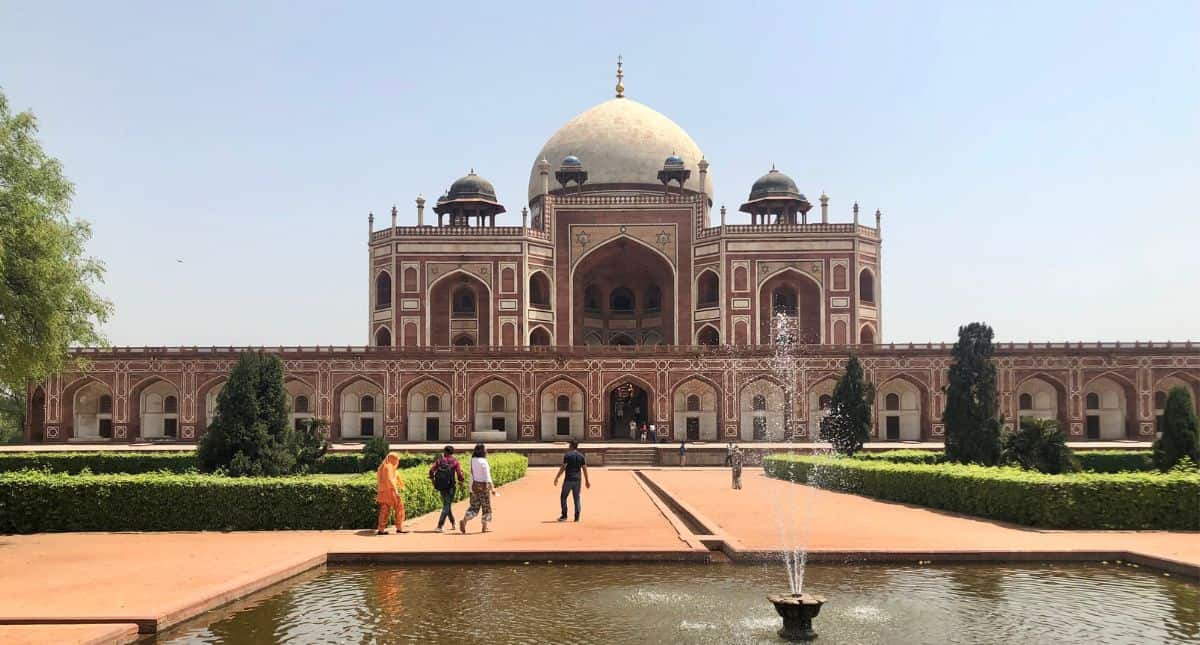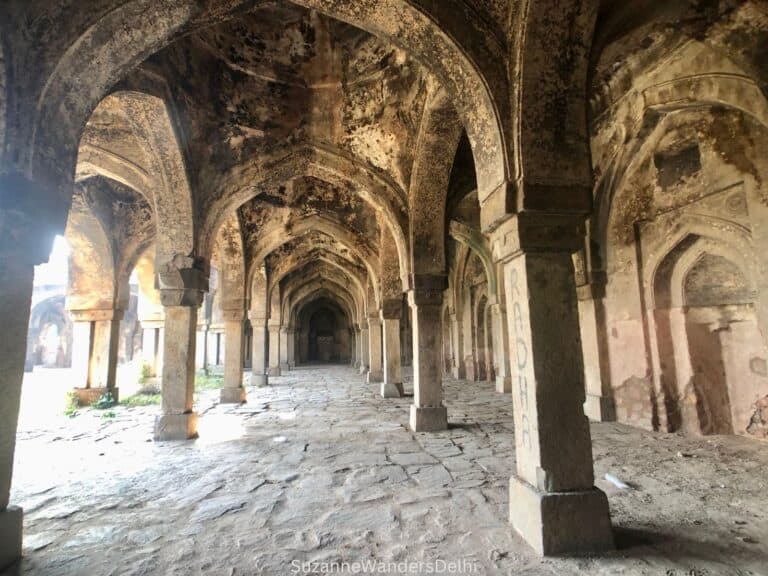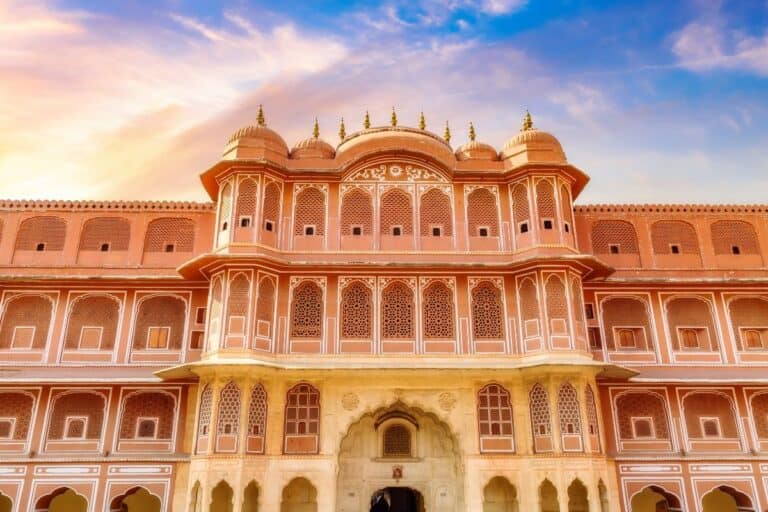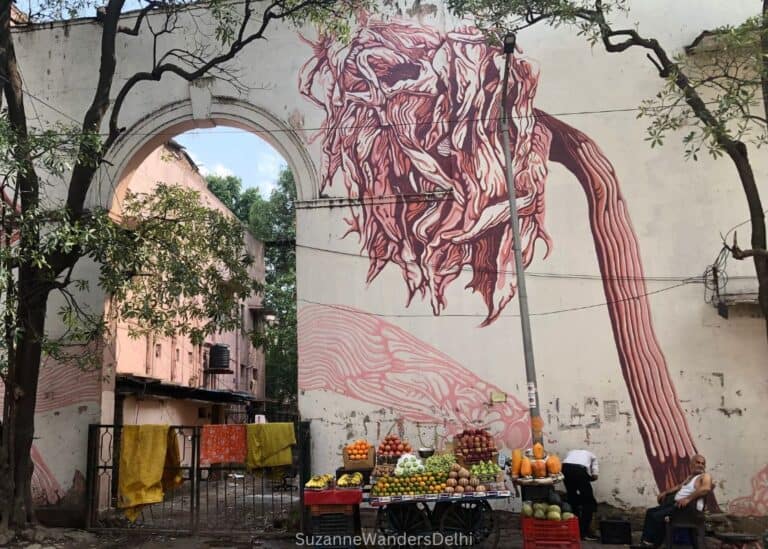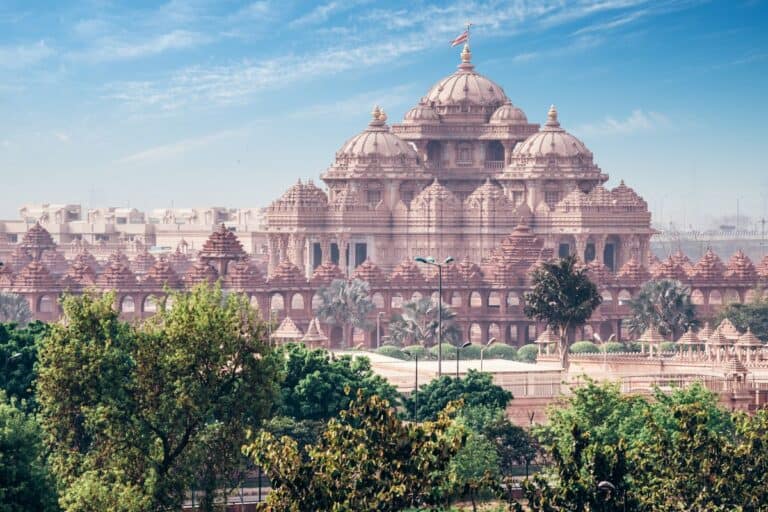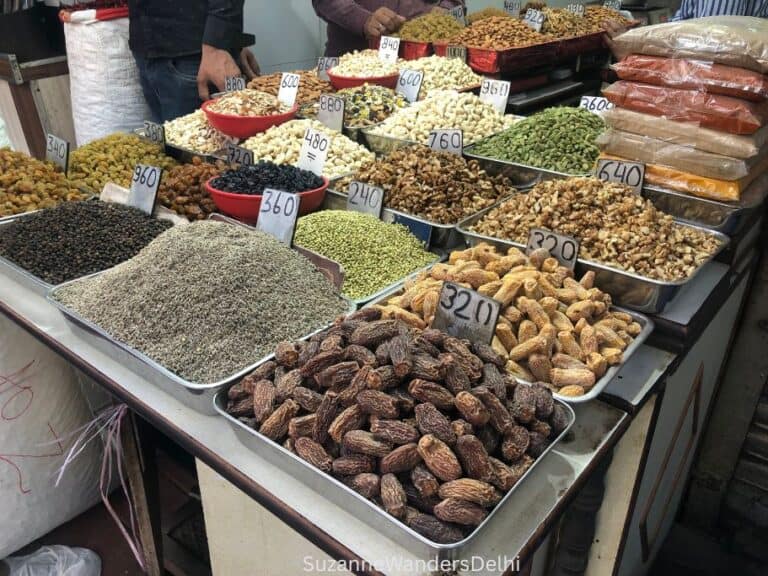Delhi Itineraries: How to Spend 5 Epic Days in Delhi

Delhi has been my home for several years, and I absolutely love it, but it’s a city you have to make an effort to know. Once you do, you’ll realize it’s one of the most fascinating cities in the world. 33 million people live here, and even on the best of days, it’s bonkers. Visitors either love the insanity, or find it overwhelming and want to get out as fast as possible. That is why I designed these Delhi itineraries.
Delhi Itineraries: How to Spend 5 Epic Days in Delhi
I guarantee if you follow these Delhi itineraries, you will fall in love with the city like I did. These itineraries will help you tackle Delhi and see all it has to offer, including must-see sites and off the beaten path gems that will make this an unforgettable trip.
If you’re still unsure about exploring Delhi on your own, why not take one of these 6 Delhi sightseeing tours? A tour is a great way to ease yourself into a new destination and build confidence, so you can explore independently after.
Delhi Itineraries – Day 1: A Soft Landing
These Delhi itineraries are designed to ease you into the craziness of Delhi. Start your first day in one of the loveliest parts of South Delhi. Fuel up on breakfast at your hotel and make your way to every Delhiites favourite park, Lodhi Garden.
If your hotel does not provide breakfast, start the morning at Habitat Hub restaurant at India Habitat Centre. They open at 8:00 am and serve American and Indian food. While there, take a look around at the public art on the grounds. It’s right across the street from your first stop.
Morning: Lodhi Garden
Delhi is a very historic city, and nowhere is this more apparent than in the most beautiful public park, Lodhi Garden.
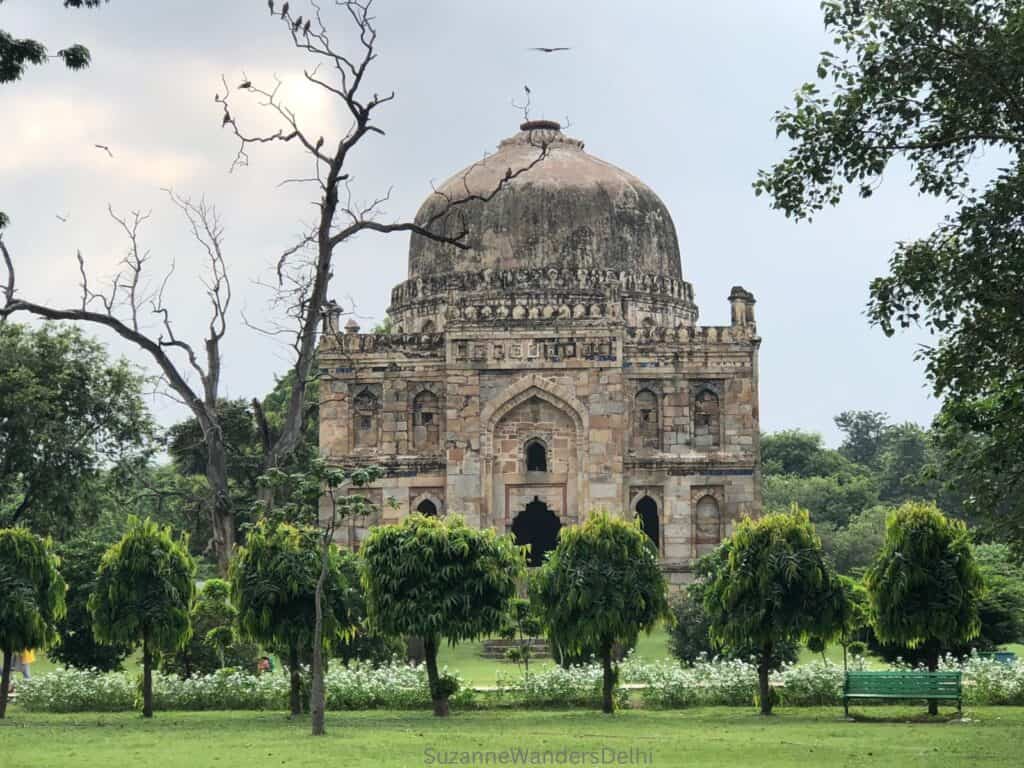
The park itself is gorgeous and has over 100 species of trees, shrubs and flowers which are home to a variety of native birds and butterflies. But the real magic are the ancient monuments scattered over the grounds.
The park was planned by Lady Willingdon in 1931 (wife of the British Viceroy at the time – Delhi was colonized by the British and formed part of their Empire until 1947). Thankfully, the existing tombs, ancient mosque and arched bridge were left in place, unlike the two villages which were razed to the ground for the landscaping. These historic structures are from the Sayyid and Lodhi periods (1414 to 1526) of Delhi and are mesmerizing.
Make sure you have your camera – you’ll want to get photos here.
Hours and Cost: 6:00 am to 7:30 pm, daily – free
Lodhi Art District
Directly across Lodhi Road is India’s first outdoor art district. Stroll through the relatively calm lanes and roads of Lodhi Colony to view the 50 + murals.
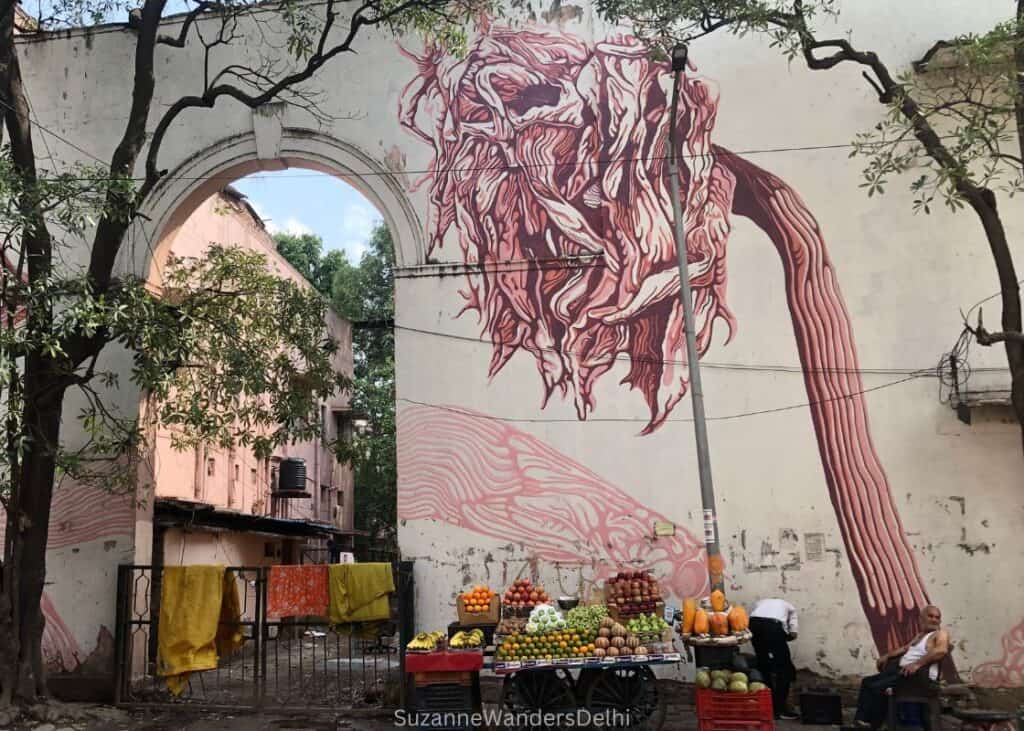
A number of international artists have graced the facades of the British built low rise apartment buildings with their art, and nearly all have a social or environmental theme.
If you’re in need of a break, Devan’s South Indian Coffee is an excellent local coffee house at the bottom of Lodhi Colony. For something sweet, stop at Jaatre, one of the best spots in Delhi for ice cream. It’s in Meharchand Market (on the main road through Lodhi Colony).
Hours and Cost: 24/7 but to see the murals go in the daytime – free
Afternoon: Khan Market & Lunch
Khan Market is Delhi’s favourite upscale market and it will be a great place for lunch. It’s super easy to get to from Lodhi Colony – just grab an auto rickshaw for the short ride.
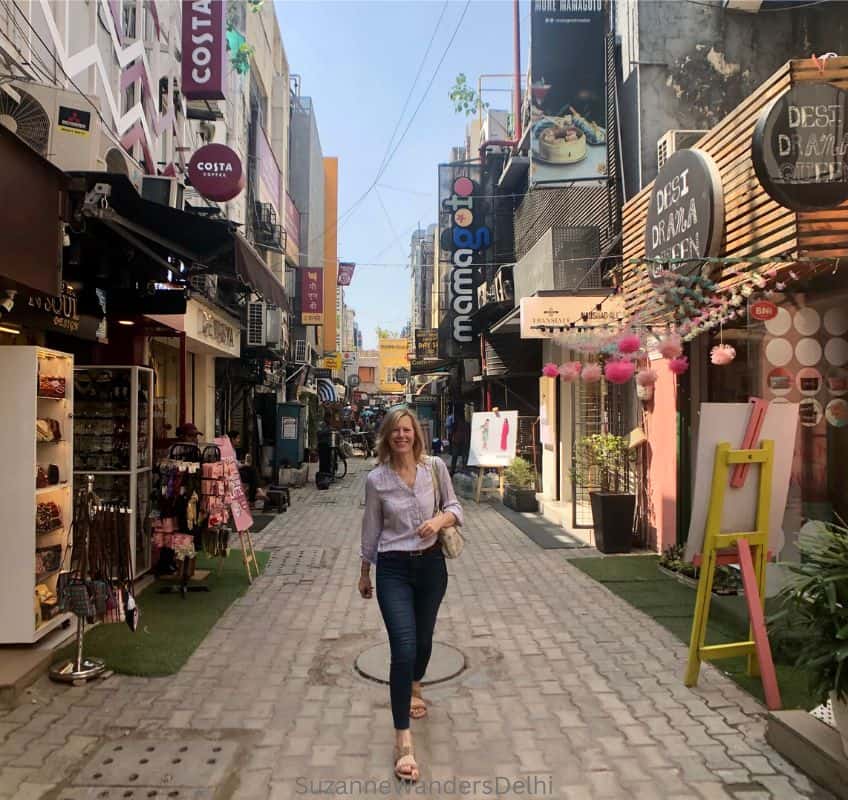
This is a more upscale and quiet market (by Delhi standards) to browse around. It’s full of international and Indian brand shops, cafes and restaurants. There’s fabulous jewelry (mid-price point), book shops, Indian clothing shops, shoe stores, small gourmet food shops, chocolate shops – Khan Market has everything!
Great options for lunch are: the Big Chill, Yum Yum Cha, Sly Granny and Punjab Grill. For something cheap and fast, grab a kathi roll from the Khan Chacha stand in the middle of Khan Market.
Hours and Cost: 10:00 am to 12:00 am, daily (hours may vary) – free
Gandhi Smriti Museum (aka Birla House)
Mahatma Gandhi is revered all over India and still considered the Father of the Nation. He helped lead India to independence from British rule and his philosophy of non-violence inspired civil rights leaders around the world.
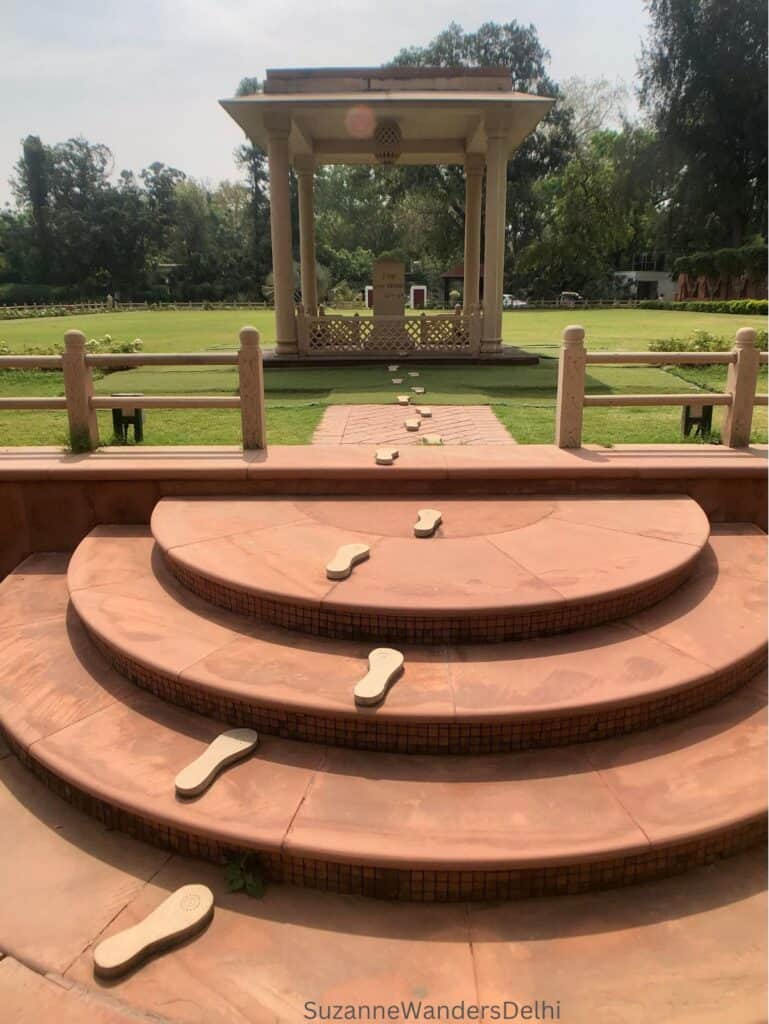
Gandhi Smriti Museum is the house Mahatma Gandhi stayed at during the last months of his life. At the time it was owned by the Birla family and known as Birla House.
The rooms Gandhi stayed in have been carefully preserved, even with Gandhi’s spectacles. The museum is very moving and many visitors report feeling a sense of Gandhi’s presence. He was assassinated in the gardens on January 30, 1948.
Hours and Cost: 10:00 am to 4:30 pm (closed Monday) – free
Bikaner House
For some reason Bikaner House seems to fly under the radar of most visitors – it’s rare that I see tourists in there. It was built as a palace for the Maharaja of Bikaner, but in 2015 was converted into an art and cultural centre to promote Indian talent. Not only are the grounds and building beautiful, it’s a peaceful reprieve.
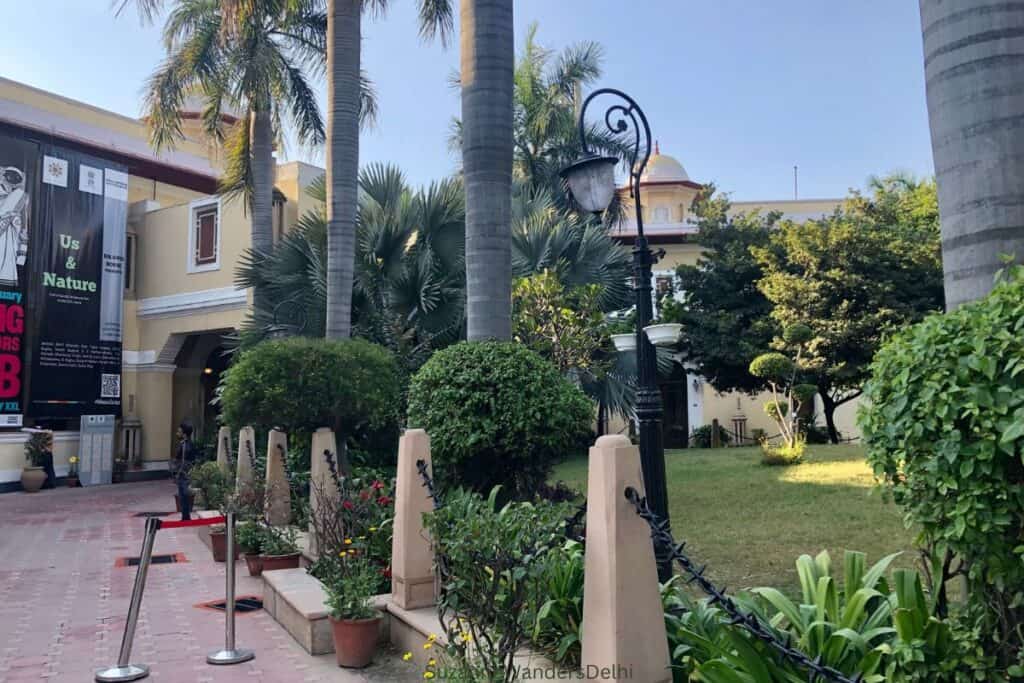
There’s always at least one and usually two or three art exhibits happening, all free. If you feel like relaxing over a tea and snack, Bikaner House has several nice cafes. Diggin Cafe and L’opera are both excellent.
Hours and Cost: 11:00 am to 7:00 pm, daily – free
India Gate and optional Rashtrapati Bhavan
Now it’s time to see one of Delhi’s most iconic sites, India Gate. It’s a very short walk from Bikaner House to India Gate Circle (5 minutes) where you will see the entrance for India Gate.
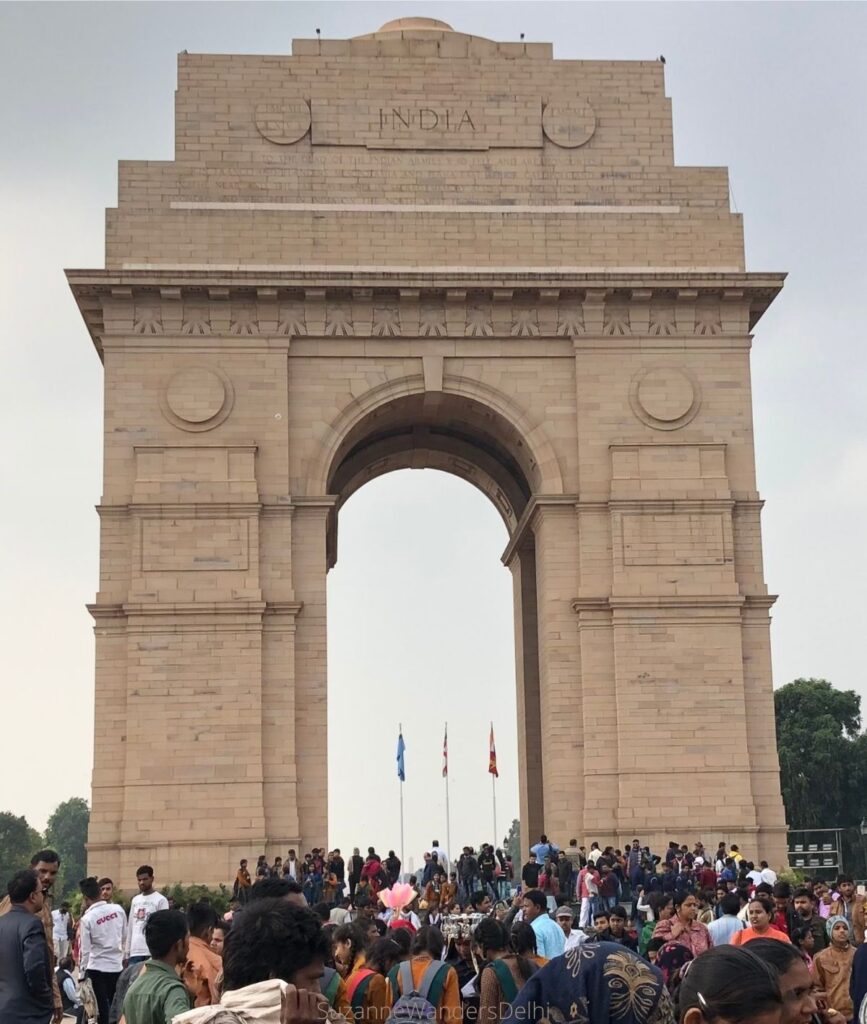
This is Delhi’s war memorial, built in the style of the Arc de Triomphe in Paris. It is dedicated to the soldiers who lost their lives in WWI and the Anglo-Afghan war of 1919 – an eternal flame commemorates the lives lost.
Indians are fiercely patriotic, and the area is a constant hive of activity. I don’t think I’ve ever seen India Gate not thronged with Indian families. The people watching is just as interesting as the monument itself.
If you’re feeling energetic you can walk along Kartavya Path to Rashtrapati Bhavan, Delhi’s parliament buildings – it’s about 2 km.
Hours and Cost: 7:00 am to 11:00 pm, daily – free
Evening: Dinner at Pandara Road Market
The hub of restaurants on Pandara Road is very popular with locals but doesn’t feature on many Delhi itineraries. If you go during Indian dining times (8:00 pm onwards) be prepared to wait, especially on the weekend.
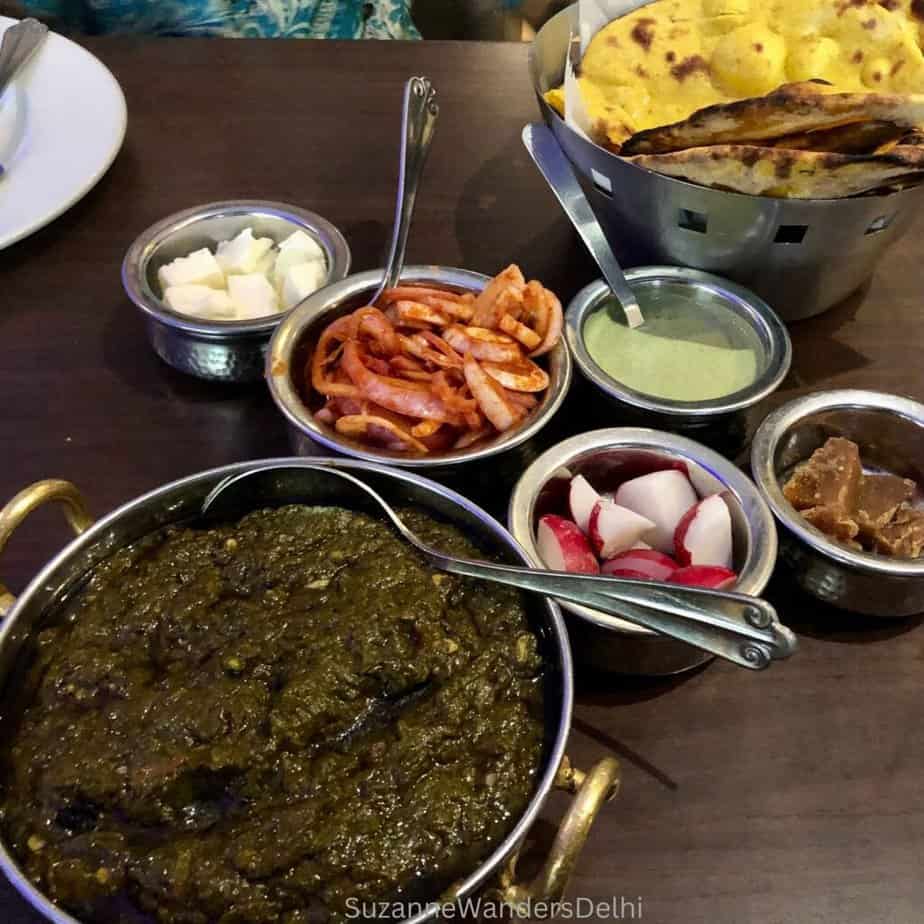
You can easily walk there from India Gate in 10 minutes. You’ll see there are many options in this small hub.
Most of the restaurants serve Indian food but there is an Ichiban which specializes in Asian cuisine. Gulati is the best Indian restaurant in this complex, and they serve one of the best sarson ka saags in Delhi. While you’re there have kulfi (Indian ice cream) Krishna di Kulfi stand beside Gulati. They sell some of the best kulfi in all of Delhi.
Hours: 12:00 pm to 12:00 am, daily
Night Cap with a View at Cirrus 9, the Oberoi
If you’re not ready to call it a night, after dinner take an auto rickshaw to one of Delhi’s best hotels, the Oberoi. The rooftop bar Cirrus 9 has panoramic views of Delhi. One look and you’ll understand why Delhi is one of the greenest capital cities in the world. You can see several Mughal monuments from the rooftop, including Humayun’s Tomb (UNESCO).
Drinks aren’t cheap, but they are served with bar snacks and service is impeccable.
Hours: 5:00 pm to 1:00 am, daily
Delhi Itineraries – Day 2: Getting off the Beaten Path
Your day will start on the beaten path at one of Delhi’s UNESCO heritage sites, the Qutub Minar, but I promise after that you’ll be going to places that aren’t found on any Delhi itineraries. This is going to be a big day, so fuel up on breakfast and wear comfortable shoes.
Morning: Qutub Minar Complex (UNESCO World Heritage)
The Qutub Complex is a wonderful example of Indo-Islamic-Afghan architecture dating back to 1192. The complex houses the ruins (some are in excellent condition) of tombs, a mosque, madrassa and of course the famous Qutub Minar, the tallest brick minaret in the world.
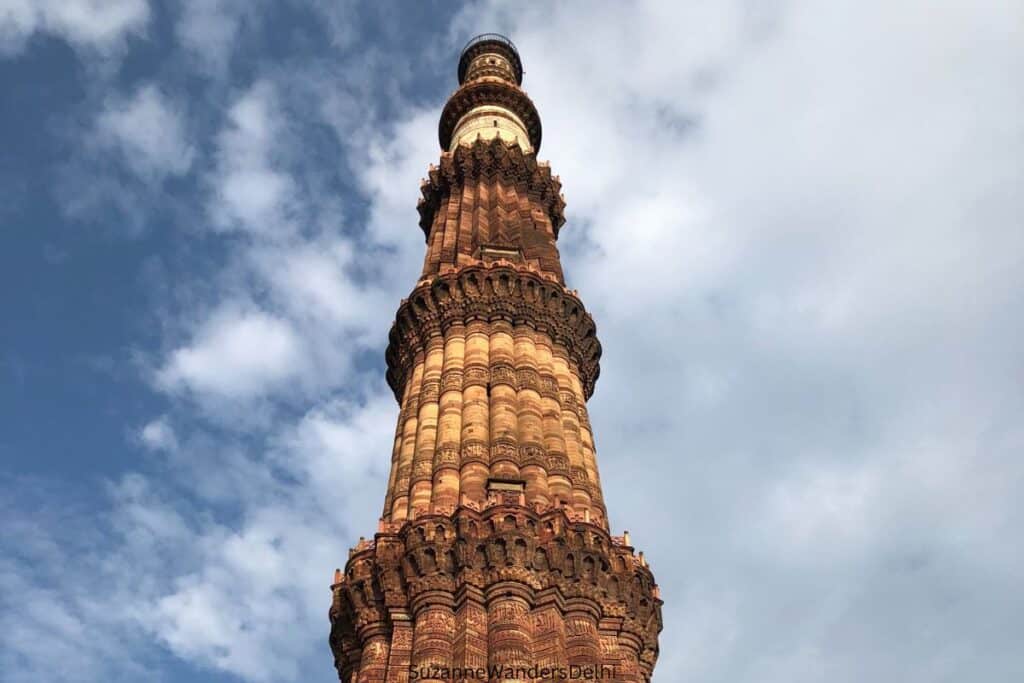
It’s a beautiful, evocative place that was built on the site of ancient Hindu and Jain temples. Some of the stones from the torn down temples were re-used in construction of the Quwwat-ul-Islam mosque. If you look at the columns in the mosque you’ll notice the Hindu and Jain deities and designs. This kind of archeological pillaging was common practice at the time.
For a small discount and to avoid the ticket line-up, buy tickets in advance through the ASI portal: https://asi.payumoney.com.
Hours and Cost: 9:00 am to 8:00 pm, daily – INR 600 for foreigners, children under 15 free
Mehrauli Archeological Park
This is Delhi’s only archeological park, and it’s spectacular. You can easily walk to the ticket booth and entrance from the Qutub Minar, it’s just down the road.
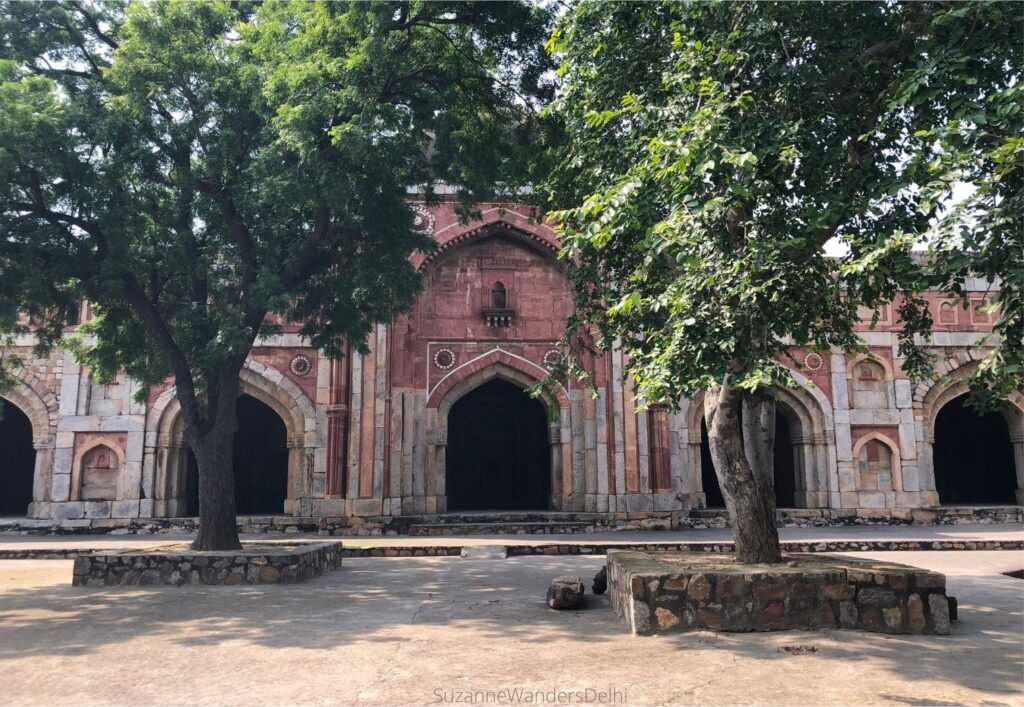
Mehrauli Archeological Park is a large parkland, partly forest, party gardens, with the most amazing ruins ranging from pre-Islamic to the late Mughal eras. The footpaths and lanes through the forested area lead to some beautiful structures.
The monuments you absolutely must see are the Rajon ki Baoli (one of Delhi’s most spectacular remaining stepwells), the Jamali Kamali mosque, and the tomb of Muhammad Quli Khan. There are many others scattered throughout the park. Many have been restored, but there are still many in ruins.
If you don’t go out the way you came, you will end up in the urban village of Mehrauli – a very congested and busy neighbourhood. If this happens, make an effort to see Zafar Mahal, the summer palace of the last Mughal ruler of India, Bahadur Shah Zafar.
Hours and Cost: 7:00 am to 7:00 pm, daily – INR 500 for foreigners
Jahaz Mahal (Ship Palace)
If you exited the Mehrauli Archeological Park on the main Mehrauli road, take an auto rickshaw to Jahaz Mahal. If you ended up in the urban village, just walk down the main road, Kalka das Marg to Jahaz Mahal – it’s about 12 minutes.

It was built during the Lodhi dynasty, 1451 – 1526, to accommodate the women of the royal harem of Sultan Ghiyas-ud-din Khilji. At that time it was flanked by two ponds and the reflection of the palace looked like a ship – hence the name Ship Palace.
There is usually a caretaker here and if you tip him (INR 100 should suffice), he may let you up the locked stairs to get up to the roof.
Hours and Cost: 24/7 but for safety reasons go in the daytime – free
Afternoon: Dastkar Nature Bazaar & Lunch
From Jahaz Mahal, take an auto rickshaw to Dastkar Nature Bazaar. By now you’re probably hungry, so go to the food court and have some lunch.
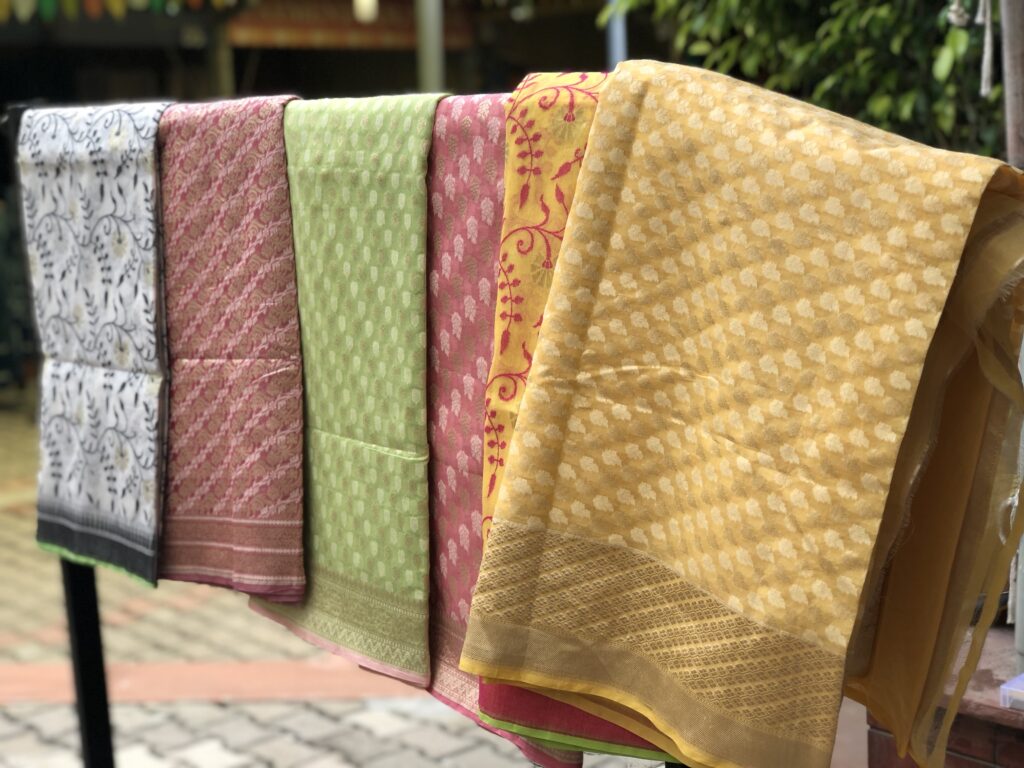
This is a market with a social conscience. Delhi Tourism and NGO Dastkar joined forced to support crafts people by giving them opportunities to upgrade their skills, develop products for consumers and have access to wholesale buyers and the retail market.
You’ll find a diverse range of handmade, handwoven, organic, herbal and recycled products. Everything is made using traditional methods. Most Delhi itineraries include Delhi’s favourite market Dilli Haat as a cultural experience, but Dastkar Nature Bazaar is more authentic and has a genuine mission to assist traditional crafts people.
Hours and Cost: 11:00 am to 7:00 pm (closed Wednesday but open daily during the monthly 2 week fair) – INR 30
Kururattha-Khmeraram (Cambodian Monastery New Delhi)
This small but lovely temple is right beside Dastkar Nature Bazaar. It’s the only Cambodian temple in Delhi and the architecture is unique for the city. This is another spot you won’t find on any Delhi itineraries.
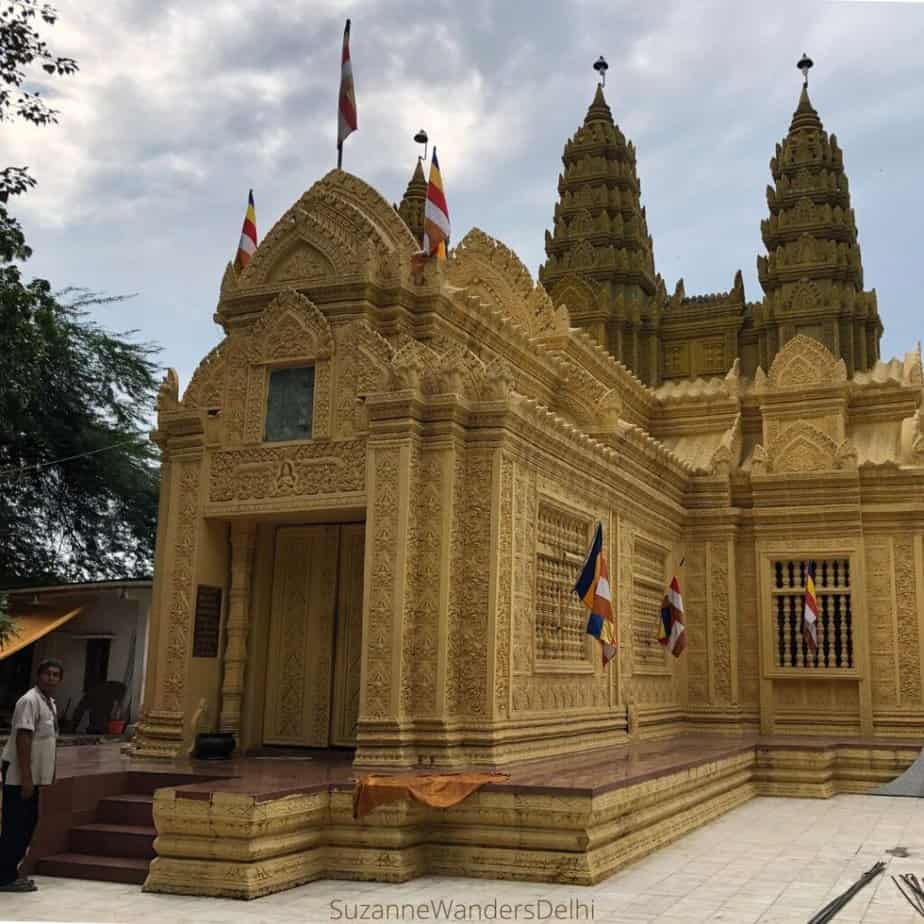
The exterior is golden and intricately carved in classical Khmer style. The interior is simple but beautiful with a large golden Buddha on a lotus flower. It was established by the Khmer-Hindu Theravada Buddhist Society in 1994 and is maintained by the Khmer Buddhist community.
There is usually a caretaker on duty and if the temple is locked you can ask him to let you inside. He may expect a small tip for this. Remove your shoes before entering.
Hours and Cost: 6:00 am to 12:00 pm & 1:30 pm to 6:00 pm, daily – free
Kiran Nader Museum of Art
The Kiran Nadar Museum of Art is a private museum which has gained India wide attention for its excellent collection. Almost all Delhi itineraries miss this art museum and it’s a shame – the collection is fabulous.
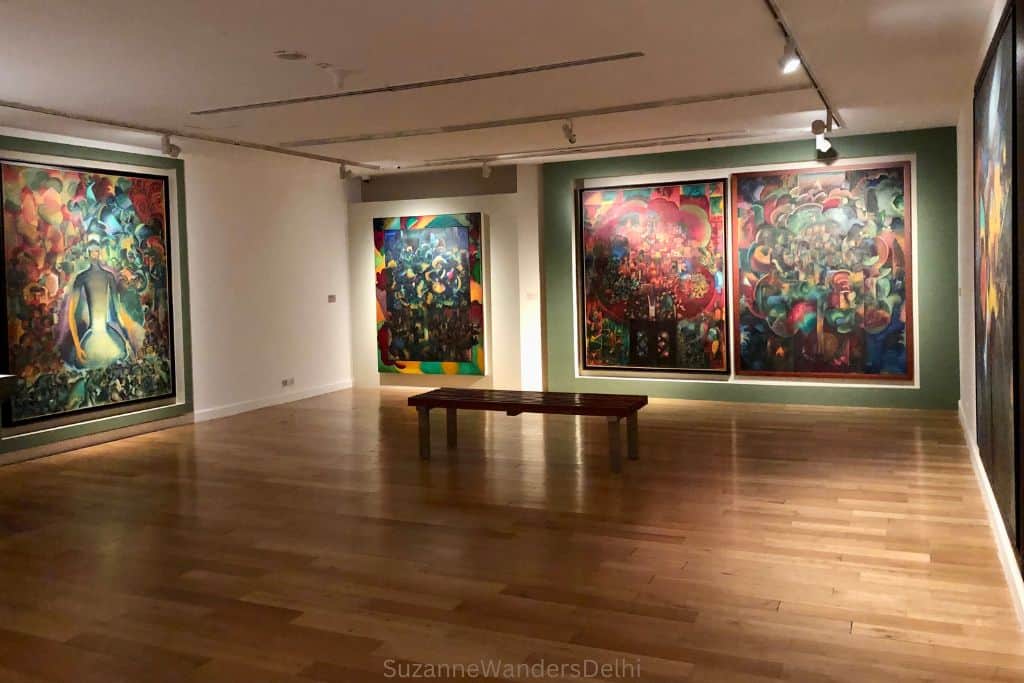
Hop on the metro from the Chhattarpur metro station and take it 2 stops to Saket. From the Saket metro take an auto rickshaw to the museum.
Art collector Kiran Nader started this museum because her collection grew too large for her home, and she wanted to bring art to the Indian public. It’s now one of the best art museums in Delhi that focuses on contemporary Indian painters.
Hours and Cost: 10:30 am to 6:30 pm (closed Monday) – free
Khirki Masjid
You can either walk or take an auto rickshaw from Kiran Nader Museum of Art to Khirki Masjid, it’s not far.
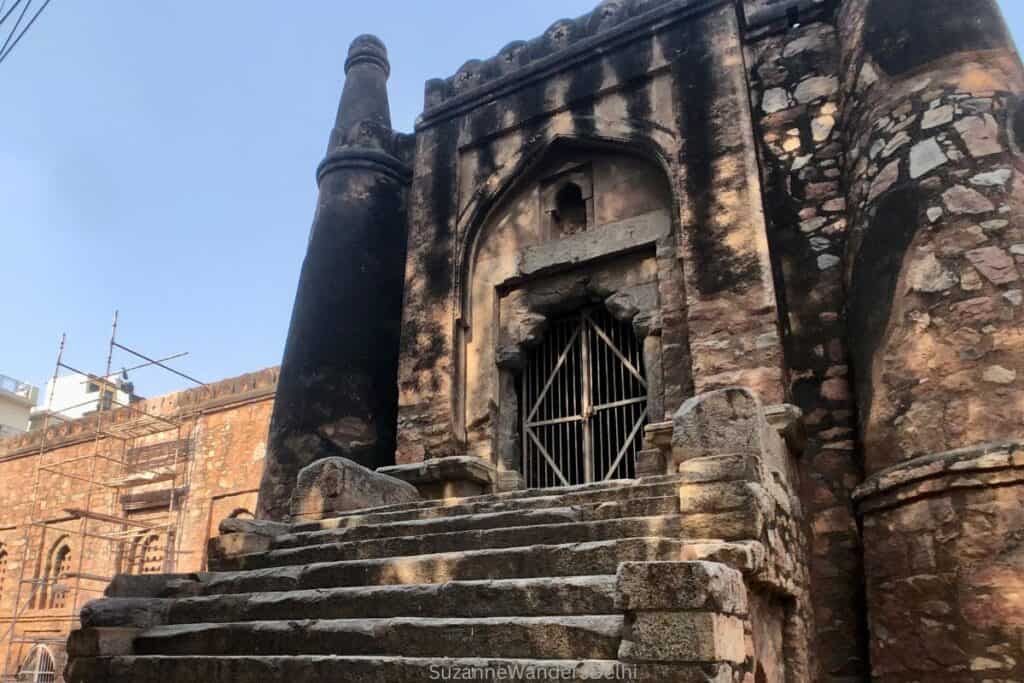
Khirki Masjid is one of Delhi’s most spectacular hidden gems. It was built in 1351 – 1354 during the Tughlaq period and the architecture is unusual for a mosque, it’s built as a fortress. You will be only the visitor here, I’ve never seen it on any Delhi itineraries.
It’s an impressive structure, tucked away in Khirki Village, hidden from the main road. Make sure you find the caretaker and ask him to let you inside. He’ll expect a small tip (INR 100 should do) but it’s well worth it. The interior is a labyrinth of columns and arches that seem to go on forever.
Hours and Cost: 11:00 am to 6:00 pm (the hours when the caretaker is there) – free
Evening: Dinner at Select Citywalk Mall
Walk back across Press Enclave Marg to Select Citywalk, one of the best malls in Delhi. There are many great restaurants to choose from. Some of my favourites are: Burma Burma, Pind Balluchi, Pa Pa Ya, The Big Chill, Social and Harajuko Tokyo Cafe.
Delhi Itineraries – Day 3: Temples and Street Food
Today these Delhi itineraries will take you across the Yamuna River. You’ll see three of the most famous temples in Delhi, visit a street food market and check off another UNESCO heritage site. Have a good breakfast and head out to your first stop.
Morning: Swaminarayan Akshardham (Akshardham Temple)
The easiest way to reach Akshardham Temple is by Delhi metro. See my guide on how to use the Delhi metro – it’s really the best way to move around the city. The Akshardham metro station is a 10 minute walk from the temple entrance.
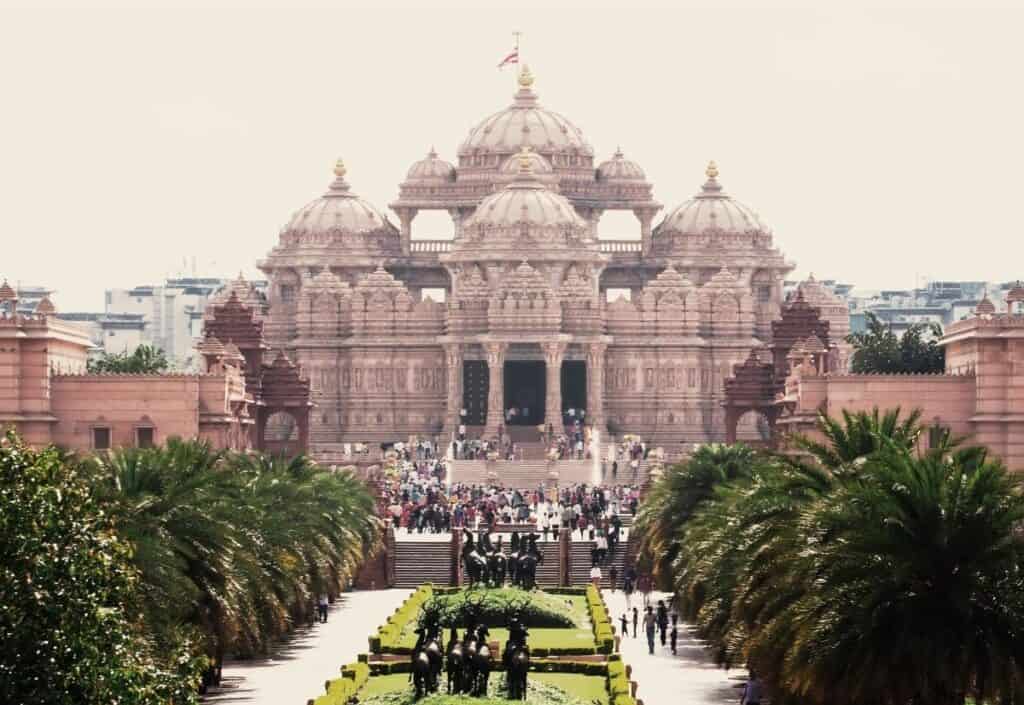
Not only is Akshardham Temple one of the largest Hindu temples in the world, it’s also one of the most exquisite. It’s made entirely of hand carved Carrara marble and pink sandstone without any structural steel. It’s some of the most breathtaking architecture I have seen anywhere in India.
Besides the temple there is a cultural boat ride, a giant screen movie and a series of 3D dioramas. The temple itself is free, but there is a small fee for the ‘exhibitions.’ Akshardham also has an excellent food hall, so if you’re hungry it’s a good place to grab something.
You’ll have to remove your shoes to enter the temple and be sure to dress modestly (knees and shoulders covered). Security is strict at Akshardham – electronic devices (including cameras and phones) are strictly prohibited and can be safely left at the security counter.
Hours and Cost: 10:00 am to 7:00 pm (closed Monday) – free
Humayun’s Tomb (UNESCO World Heritage)
To get to Humayun’s Tomb, either take an Uber from Akshardham Temple or take the metro to Supreme Court station and grab an auto rickshaw from there.
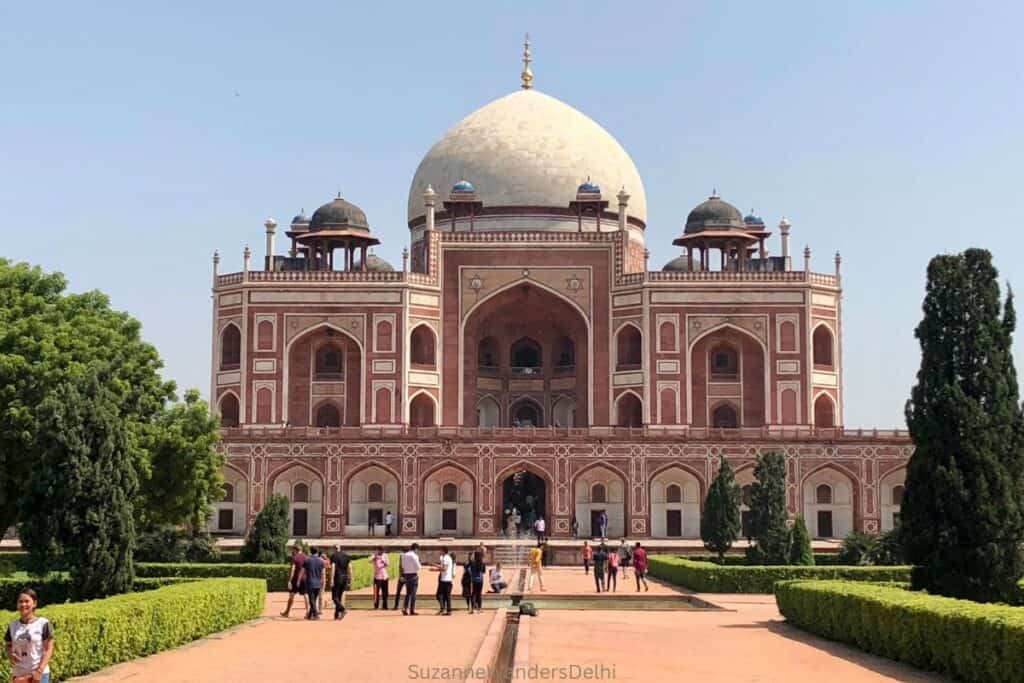
This is the first garden tomb built in India, and the first to use red sandstone on such an immense scale. It was built in 1569 for the Mughal Emperor Humayun by his favourite wife who was devastated by his death. While Humayan was considered an ethical and educated ruler, he was not a strong leader and in fact lost his kingdom, went into exile, and finally regained the throne 15 years later.
The complex has several other beautiful mausoleums, Persian gardens and the graves of 150 Mughal royals and their entourage. If you’re awake early today you can do Akshardham Temple and Humayun’s Tomb in reverse – Humayun’s Tomb opens early at 8:00 am.
For a small discount and to avoid the ticket line-up, buy tickets in advance through the ASI portal: https://asi.payumoney.com.
Hours and Cost: 8:00 am to 6:00 pm, daily – INR 600 for foreigners, children under 15 free
Afternoon: Amar Colony Food Market
Delhi has a vibrant street food scene, there are food stalls everywhere. Not only is street food fresh and delicious, it’s cheap and reflects the multi cultural nature of the city.
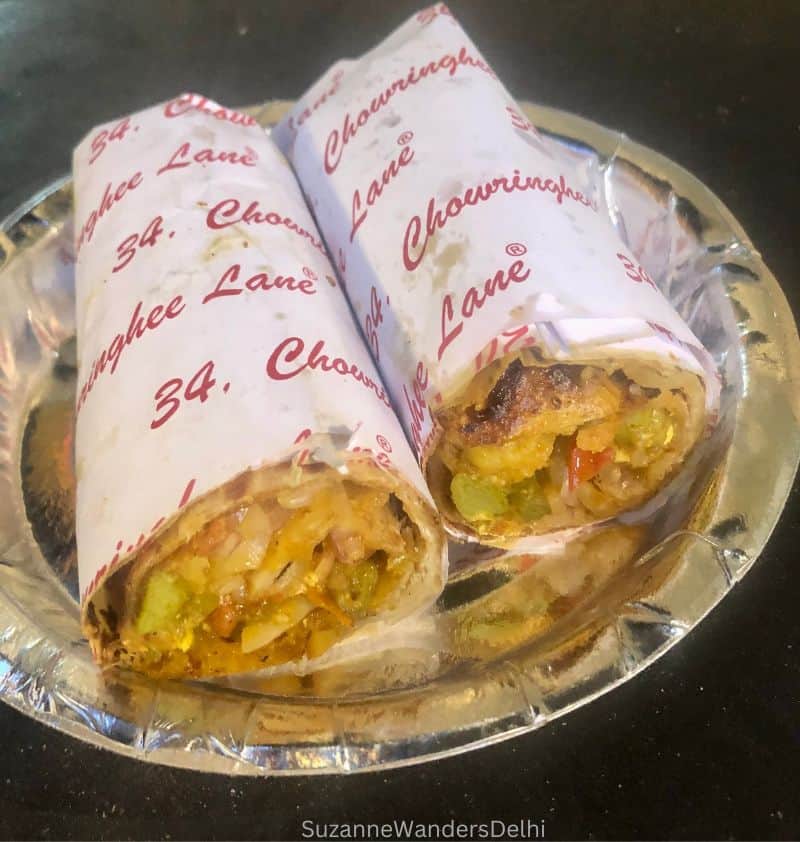
From Humayun’s Tomb either take an Uber or the metro four stops from JLN Stadium metro station to Kailash Colony metro station and take an auto rickshaw from there.
Most street food tours and Delhi itineraries focus on Old Delhi, and while that is considered ground zero for Delhi street food, I prefer the much quieter and easier to navigate Amar Colony Food Market. Amar Colony is a mix of immigrants, refugees and Indians, and the market reflects the mix of cultures. This is where you find delicious Afghani shawarma, mutton kababs, sweet faluda, Tibetan laphing and traditional Indian chaats, all in one compact area.
Before eating street food, see my tips on how to eat local and stay healthy. It is absolutely doable to eat street food and not get sick. Eating street food is one of the most authentic cultural experiences you will have in Delhi, don’t miss out!
Hours and Cost: 12:00 pm to 9:00 pm, hours can vary (closed Monday) – prices range from INR 80 to INR 300.
Bahai Lotus Temple
This is one of the most famous religious buildings in the world. Built of marble in the shape of a lotus flower, it is on the UNESCO World Heritage Tentative List. Iranian architect Fariborz Sahba has won numerous awards for the temple’s unique architecture.
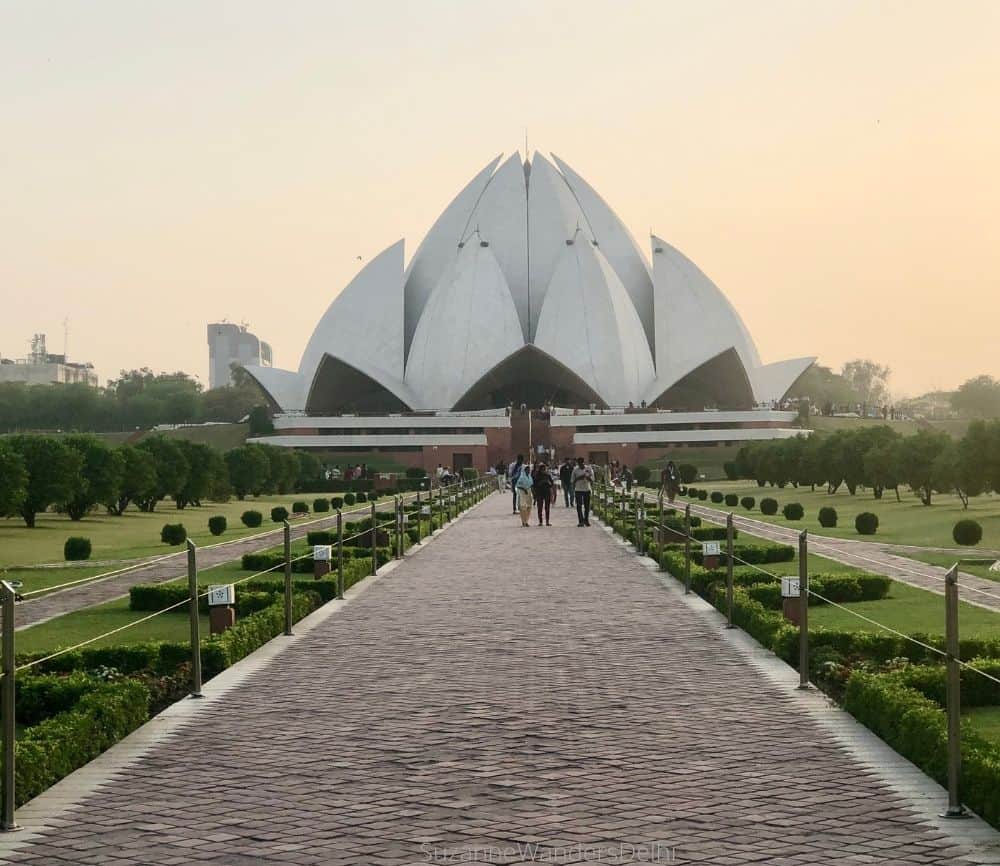
Bahais believe in the oneness of God and unity of all people. There are no deities or religious images inside the prayer hall. It is an expansive and calm space, beautiful in its simplicity.
The temple gets very busy on weekends and there’s usually a line up. While it’s not on most Delhi itineraries, it gets a lot of domestic visitors. Volunteers are always on hand to keep the queues moving. Shoes must be removed before entering. Photography is not permitted inside the temple without prior permission.
To reach the Lotus Temple from Amar Colony Food Market, hop on the metro at Kailash Colony station and take it 2 stops to Kalkaji Mandir station. You can walk to the Lotus Temple from there.
Hours and Cost: 8:30 am to 5:00 pm (closed Monday) – free
Kali Mandir (Chittaranjan Park)
On your way to your dinner destination, stop at this traditional Bengali temple devoted to the goddess Kali. Kali is perhaps the most important goddesses in the Hindu faith, often thought of as the Mother Goddess.
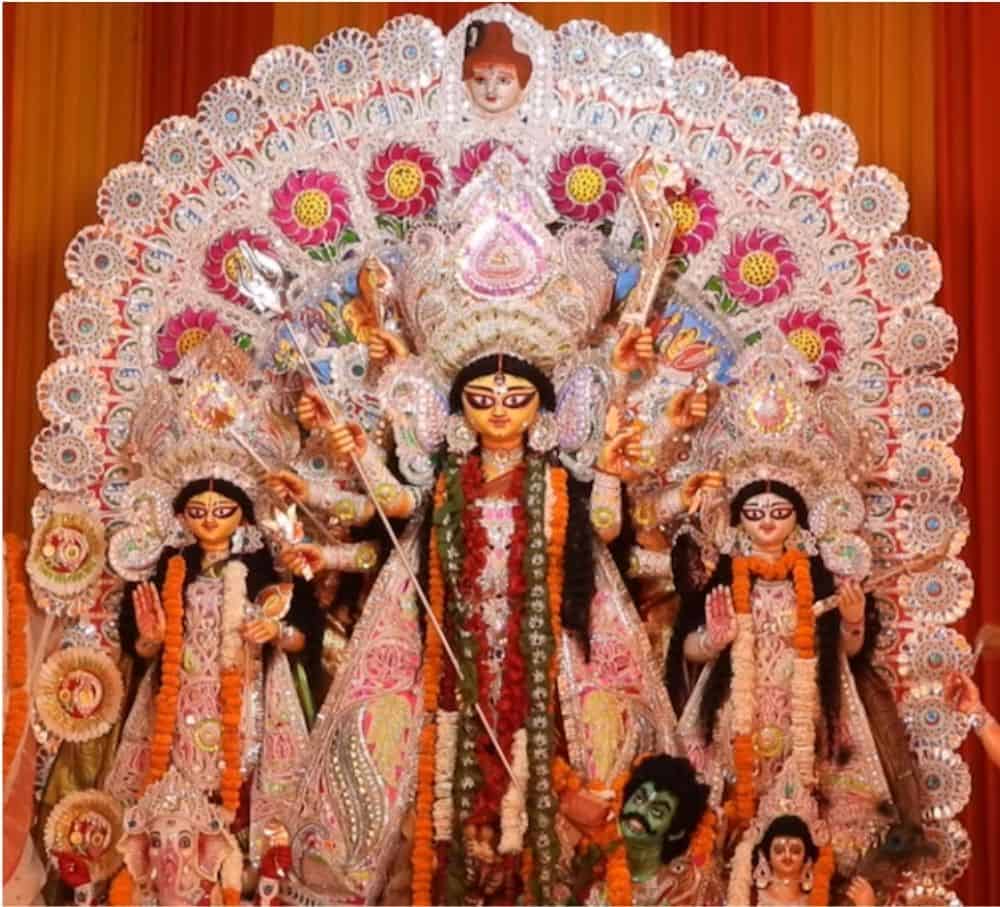
Either grab an Uber or auto rickshaw to Kali Mandir, just make sure the driver takes you to the Kali Mandir in CR Park (Chittaranjan Park).
More than a temple, the Kali Mandir serves as a cultural centre for the Bengali community of Delhi. It is located in CR Park, which has a large Bengali population.
Avoid this area during the festival of Durga Puja (usually in October) when the neighbourhood is thronged with thousands of people. Durga Puja is an amazing festival but be prepared for huge crowds.
Hours and Cost: 5:45 am to 1:00 pm & 4:00 pm to 9:00 pm, daily – free
Evening: Dinner and a Night Cap at one of Asia’s 50 Best Bars
Take an auto rickshaw to one of the best dining spots in Delhi, the GK2 M Block Market. You will have many options for dinner in this neighbourhood hot spot. Some of my favourites are:
- Miss Margita (Mexican)
- Carnatic Cafe (South Indian)
- YouMee (Pan Asian)
- Fig & Maple (European)
- Mensho Tokyo (Ramen)
- Moti Mahal (North Indian)

Not ready to go back to your hotel yet? Stop in at Sidecar, one of the best bars in Delhi. Listed as one of Asia’s 50 best bars, Sidecar is famous for its cocktails.
Delhi Itineraries – Day 4: Old Delhi
Today is the day! Now that you are somewhat acclimatized to Delhi, it’s time to head to the oldest and craziest part of the city, Old Delhi.
Morning: Red Fort (UNESCO World Heritage)
The Red Fort is one of the most visited and magnificent sites in Delhi. It can get busy, so I recommend going as early as possible and buying your tickets in advance on the ASI portal: https://asi.payumoney.com.
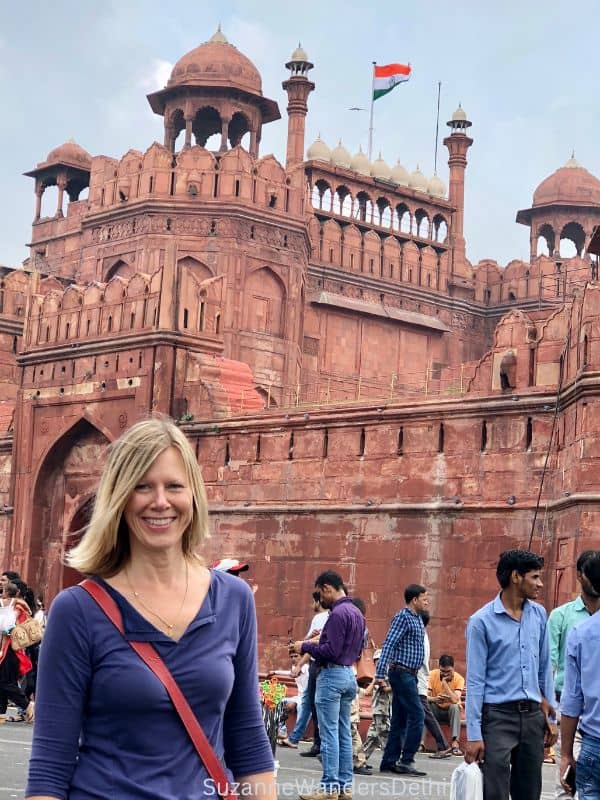
Mughal Emperor Shah Jahan (also responsible for the Taj Mahal) built the Red Fort in 1639. It remained the main residence of all successive Mughal rulers until the British imprisoned and ousted the last ruler in 1857.
During Mughal rule, the Red Fort was a world in itself with beautiful gardens, marble audience halls, palaces, baths and its own covered bazaar so the women did not need to leave the palace grounds. Hundreds of people resided and worked within the fort.
Many of the buildings were destroyed by the British during the 1857 rebellion but you can still get a feel for its past splendour.
Hours and Cost: 8:00 am to 9:00 pm (closed Monday) – INR 600 foreigners, children under 15 free. The Red Fort is usually closed around August 15th (Independence Day) – check ahead if you are planning to visit at that time.
Gurudwara Sis Ganj Sahib
From the Red Fort, walk up the main road, Chandni Chowk about 10 minutes to the Sikh temple, Gurudwara Sis Ganj Sahib. Chandni Chowk is the main road that runs from the Red Fort to Fatehpuri Masjid at the opposite end.
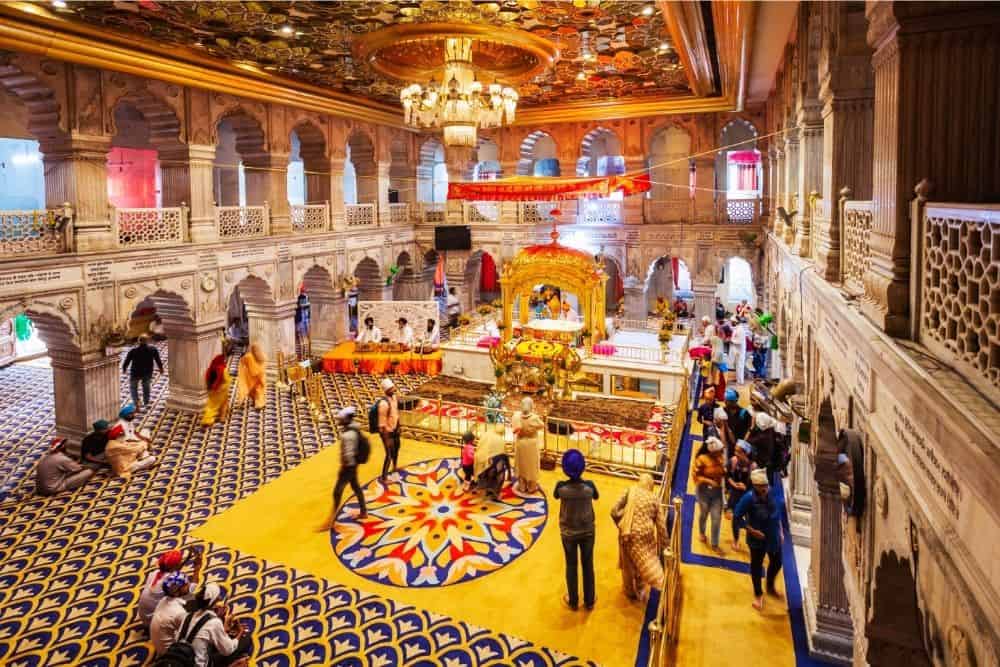
This is one of the most prominent Sikh temples in Delhi. Everyone is welcome to visit the gurudwara, but shoes must be removed and heads covered.
Ask a volunteer to show you the massive kitchen where devotees prepare food to serve in the langar hall. Langar is the free vegetarian meal provided by the gurudwara and is open to all, regardless of age, sex, race or religion. Having langar is a special experience and I encourage you to join the community meal – you will be welcomed.
Hours and Cost: 24/7 – free
Take a Cycle Rickshaw or Walk through Chandni Chowk
Chandni Chowk is closed to motorized traffic during the day so it’s quite easy to walk and explore the lanes and markets which run off of the main road. If you don’t feel like walking, just grab one of the cycle rickshaws and ask the driver to take you around the different markets of Chandni Chowk – just make sure to agree on a price first (it should be no more than INR 200).
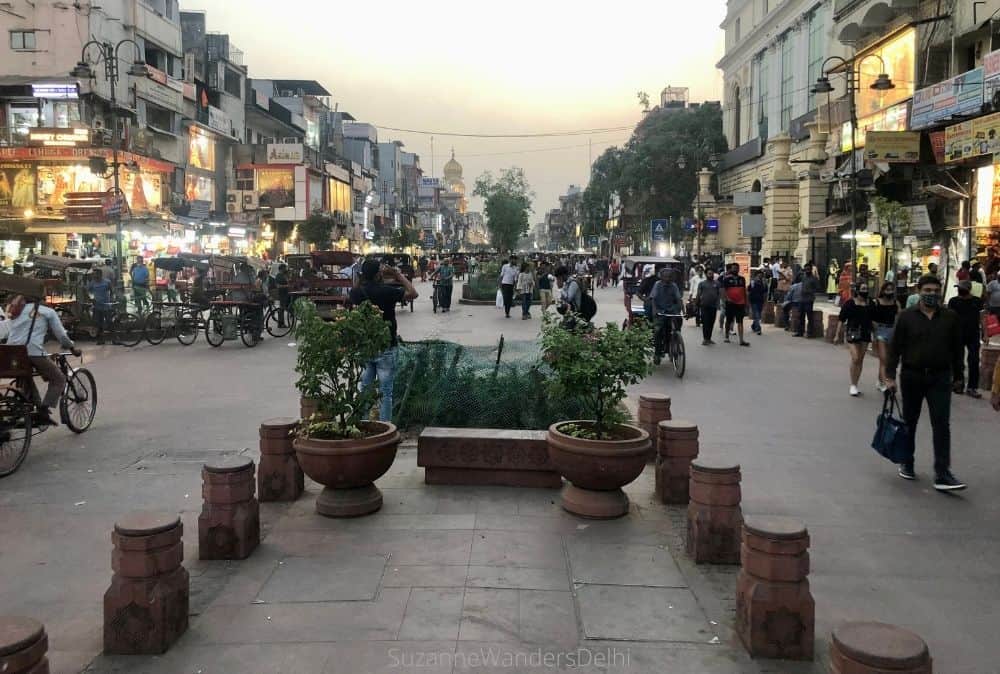
At the time of Mughal rule Old Delhi was the entire city (then called Shahjahanabad). You can still see old havelis from the 1600s scattered around the neighbourhood.
A series of specialized markets are found in the lanes off Chandni Chowk Road: Khari Baoli (the largest spice market in Asia), Kinari Bazaar (wedding bazaar), Bhagirath Palace (light fixtures) and Dariba Kalan (silver market) are just a few.
Afternoon: Lunch at a Local Dhaba
Assuming you have ended up at the far end of Chandni Chowk, near Fatehpuri Masjid and Khari Baoli (the spice market), have lunch at one of Delhi’s most famous dhabas (a casual, road side eatery), Kake di Hatti. This place is not on any Delhi itineraries and you’ll probably be the only non-local in there but don’t let that put you off, the food is excellent. Even Jamie Oliver ate at Kake di Hatti!
Hours: 8:00 am to 1:00 am, daily
Jama Masjid
From Chandni Chowk take an auto or cycle rickshaw to Jama Masjid. Jama Masjid was built in 1656 as the mosque for the palace (the Red Fort) and Emperor Shah Jahan.
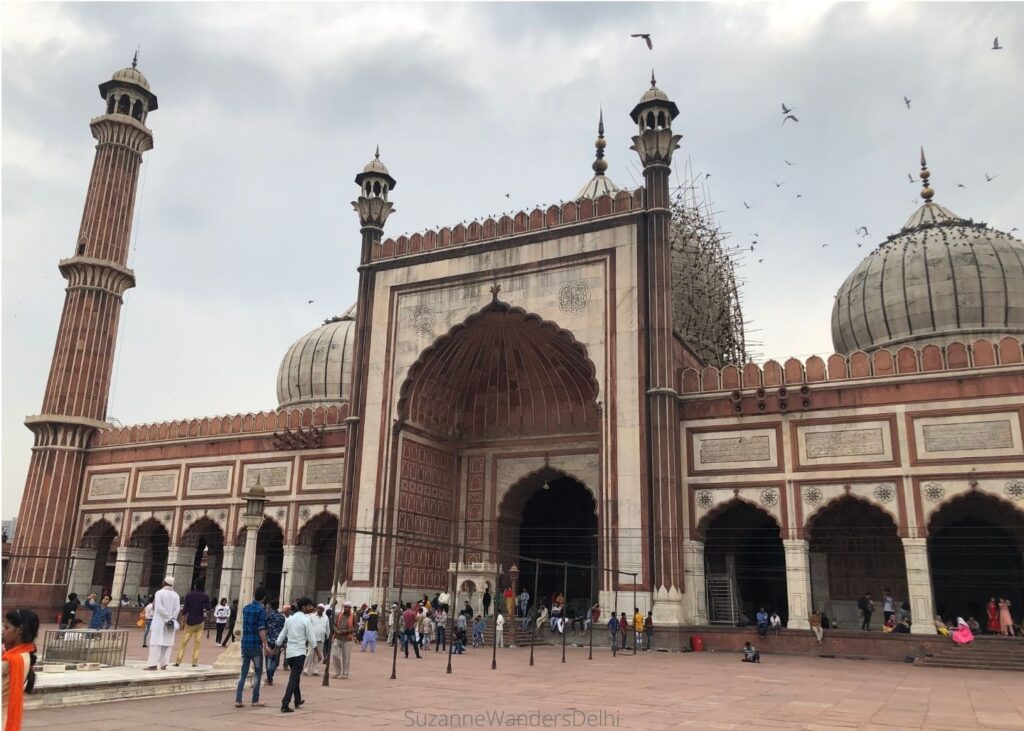
It is a beautiful marble and red sandstone mosque with three gates, four towers and two minarets. Please remember when visiting this is a working mosque and visitors must remove shoes (can be left with a shoe minder for a minimal tip or carried discretely with you), and women must cover their heads. Arms, legs and shoulders should be covered – the mosque enforces this strictly but has cover ups available to borrow.
For great views of Old Delhi (and a small fee) you can climb the towers, but be careful – they can get congested and I don’t recommend doing it alone, particularly for women.
Hours and Cost: 7:00 am to 12:00 pm & 1:30 pm to 6:30 pm, daily – free but there is an INR 300 fee for taking a camera in
Partition Museum
Take an auto rickshaw from Jama Masjid to the Partition Museum. If the driver doesn’t know where it is, tell him Ambedkar University on Lothian Road.
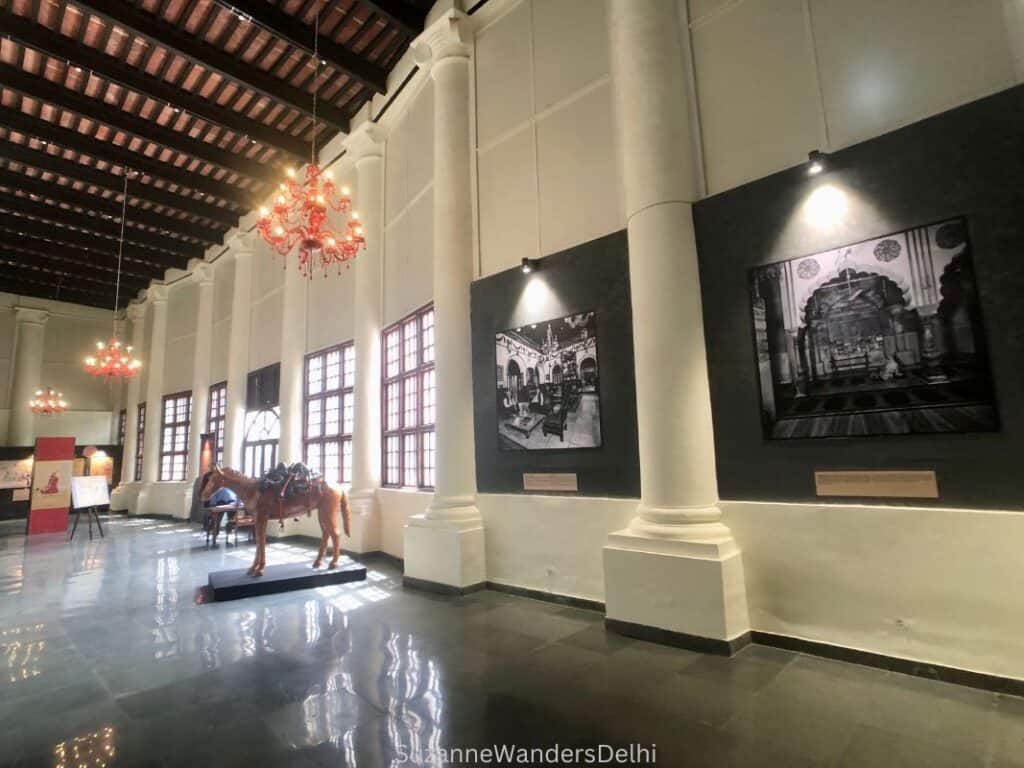
This museum is a must for anyone wishing to understand India and its people. It opened in 2023 and is the second Partition museum in India – the first is in Amritsar, the site of many atrocities.
Partition was the most defining and catastrophic moment in recent Indian history. On August 14, 1947, India was divided to become India and Pakistan. The very next day India gained independence from Britain. These events created one of the most violent and devastating exchanges of population in history, over a million people died.
Tickets are issued by a registration and token system on the museum website: www.partitionmuseum.org. The museum is located on the Ambedkar University grounds.
Hours and Cost: 10:00 am – 5:00 pm (closed Monday) – free
Evening: Dinner at one of Delhi’s Best Restaurants
It’s been a full on day, and I’m sure after the noise and craziness of Old Delhi you want something more sedate for dinner. Treat yourself tonight to some fine dining in one of Delhi’s most famous restaurants specializing in Indian cuisine:
- The Spice Route (as famous for its artistic decor as the food) – The Imperial Hotel
- Bukhara (Delhi’s most acclaimed restaurant is recognized as one of the 50 best restaurants in the world) – ITC Maurya Hotel
- Indian Accent (contemporary Indian food by chef Manish Mehrota, one of the top chefs in Asia) – The Lodhi Hotel
Delhi Itineraries – Day 5: Tughlaqabad Fort and Central Delhi
This is the last day of your Delhi itineraries. Today you will see one of the most impressive, but under-visited forts in Delhi, visit a couple of hidden gems, and have plenty of chances to do some cultural shopping before you leave Delhi.
Morning: Tughlaqabad Fort
This is one historic site that does not get the attention it deserves. Its remote location is probably the main reason few visitors come here, but it is the largest defensive fort in Delhi.
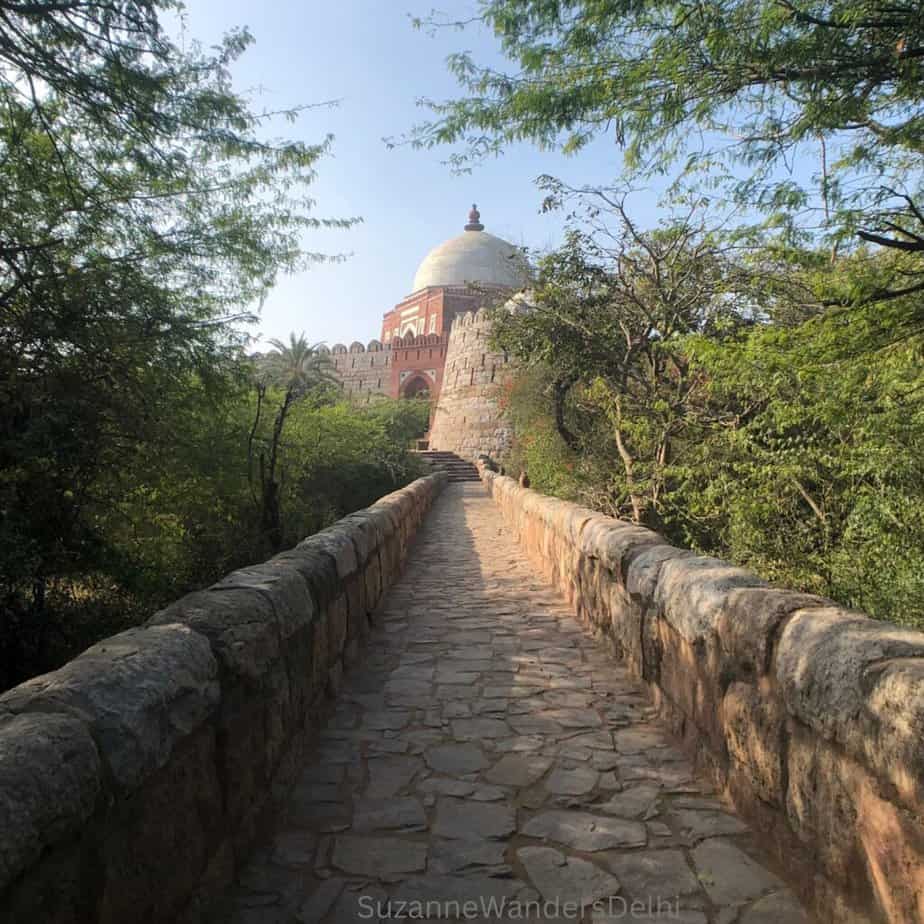
Built in 1321 by the ruler Ghiyasuddin Tughlaq, the fort has a massive citadel, giant rampart walls, parapets, underground passages, water reservoirs, a mosque, hammam, one of the deepest stepwells in Delhi, and thirteen remaining stone gates. The fort is steeped in legend and even today believed to be cursed.
The tomb of Ghiyasuddin Tughlaq, the founder of the Tughlaq dynasty, is across a stone bridge and easily accessible.
I strongly recommend you purchase your ticket online through the ASI portal: https://asi.payumoney.com. The fort is never busy, but the last few times I was there the ticket seller was late and had no change.
Hours and Cost: 9:00 am – 6:00 pm, daily – INR 300 for foreigners, children under 15 free
Agrasen ki Baoli
Either take an uber from Tughlaqabad Fort to Hailey Lane where Agrasen ki Baoli is located, or take the metro from Govindpuri station to Janpath station.

You are in for a real treat, this is by far the most beautiful stepwell in Delhi. Make sure you have your camera with you. It’s 108 steps to the bottom and the black water that pools there is believed to have mystical powers.
The original stepwell dates back to 3000 BC. The current one was built in the 14th Century by the Agrawal community. Ruins of an old mosque are also on the site, at the top of the top of the stepwell near the entrance.
Hours and Cost: 7:00 am to 6:00 pm, daily – free
Devi Prasad Sadan Dhobi Ghat
Exit Agrasen ki Baoli and turn right down the lane. You will come across one of the few remaining dhobi ghats (outdoor laundries) in Delhi.
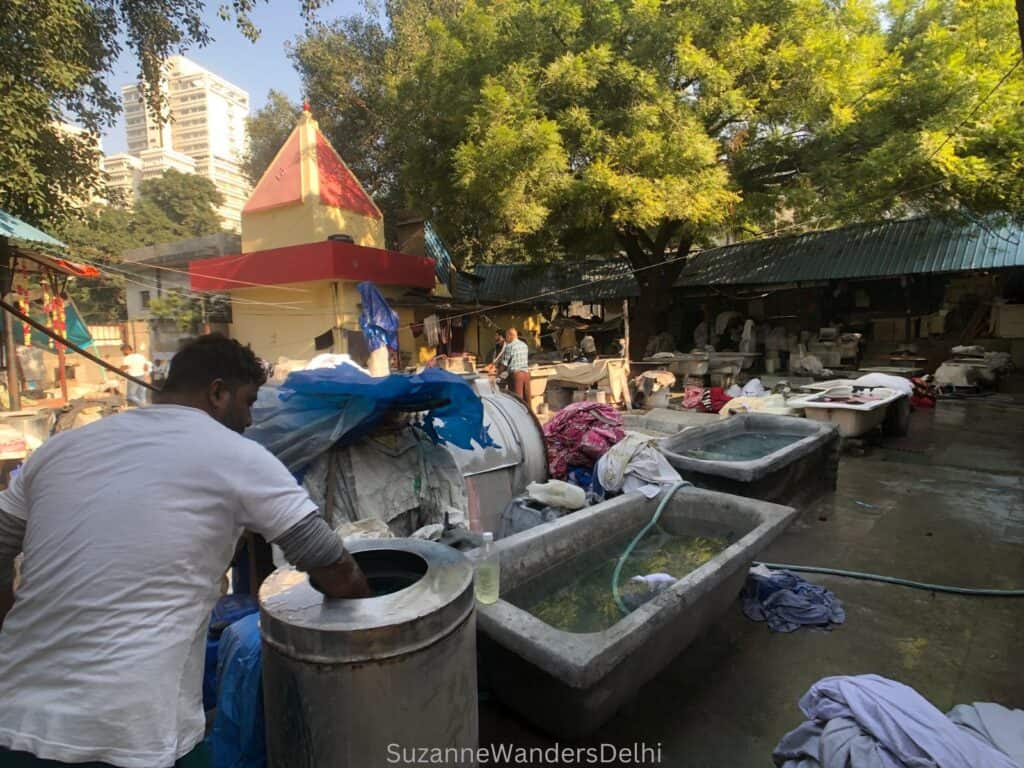
It’s like stepping back in time to see the hand crank spinners, tubs filled with soapy water and cement slabs used for beating the laundry. These dhobis have been here for generations but the future is uncertain as the younger generation don’t want to take over.
The dhobis are a friendly community but please be respectful – this is not a tourist site, it is their place of livelihood.
Hours and Cost: 5:00 am to 2:00 pm (laundry time), daily – free
Afternoon: Lunch on Janpath Road
Walk over to Janpath Road from the dhobi ghat for lunch. There are several good Indian restaurants such as Pind Baluchi, Punjab Grill and Cafe Delhi Heights, but my top pick is Saravana Bhavan which has really good South Indian food.
Janpath Market
After lunch, cross Janpath Road to the other side and you’ll see one of Delhi’s best street markets, Janpath Market.
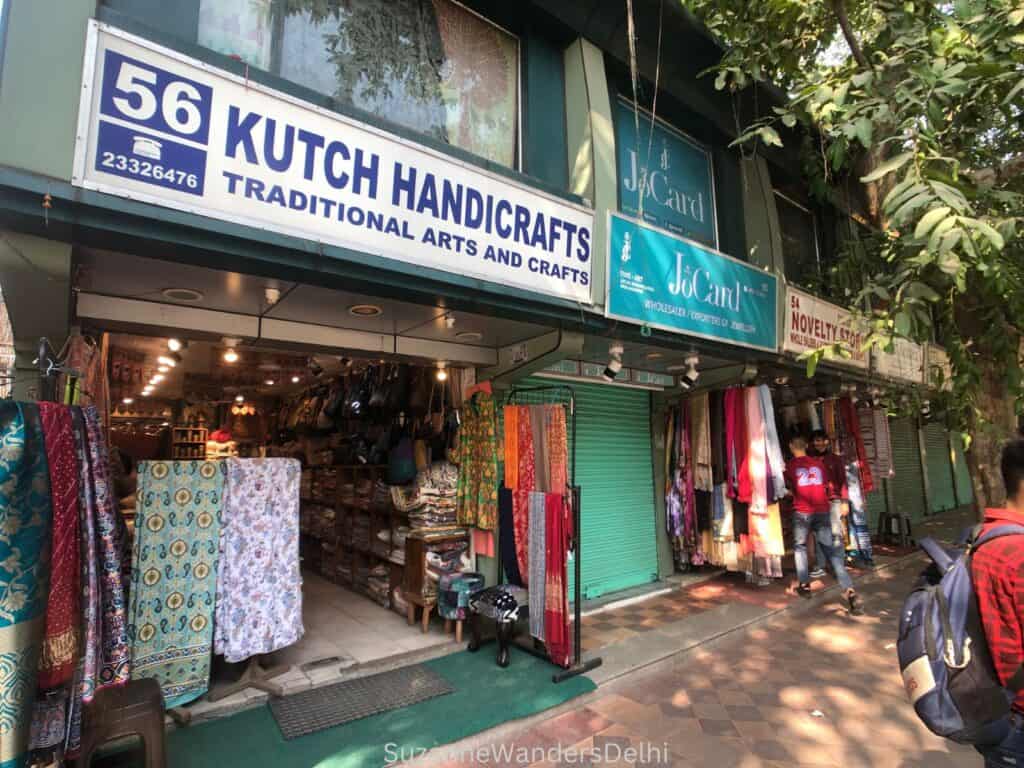
Janpath Market is actually 4 markets in one, so it’s a great place to cover some traditional Delhi market ground! There’s a Tibetan section, Gujurati section, the main market and a street market. You’ll find all sorts of souvenirs, clothing and small household items. Make sure to bargain.
I’m not sure why this market doesn’t feature on more itineraries, it’s one of the best in Delhi and is very centrally located.
Hours and Cost: 11:00 am to 9:00 pm, daily – free
Jantar Mantar
Jantar Mantar is a group of 13 architectural astronomy instruments built in 1724. For anyone interested in science or astronomy this is a must see. The Delhi Jantar Mantar is actually one of four remaining jantar mantars built by Maharaja Jai Singh II (the largest is in Jaipur).
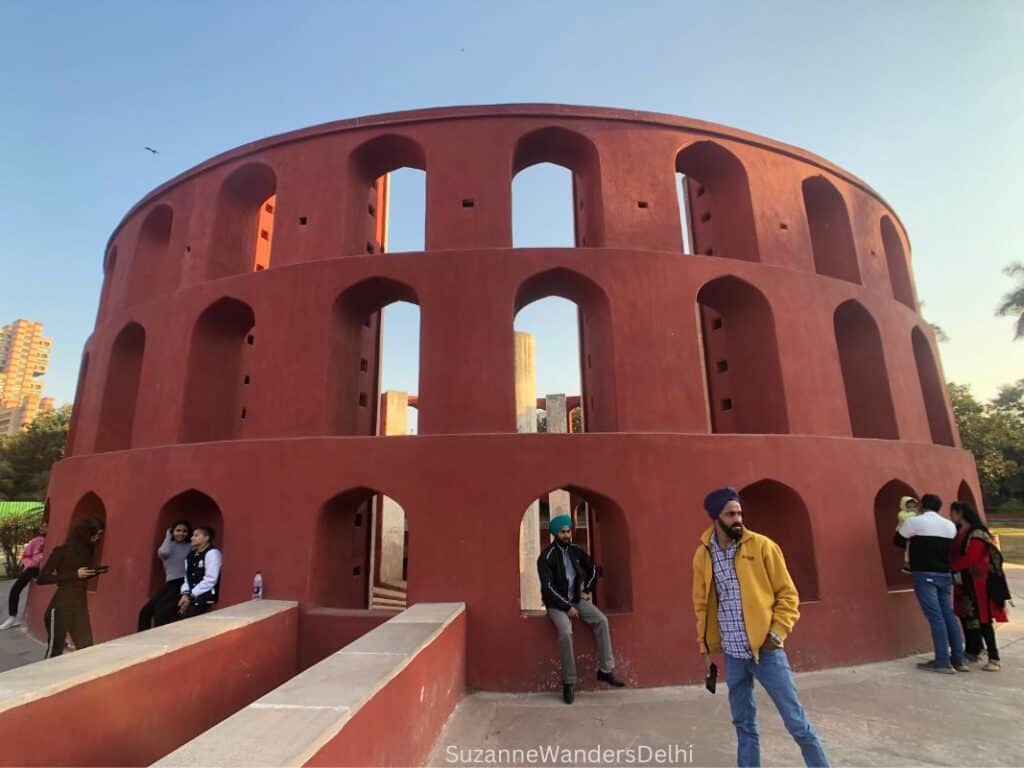
These instruments are massive, and it’s amazing how accurate they were. Today the fine calibrated markings on the instruments are severely eroded and they are in need of restoration and protection.
It’s an easy 10 minute walk to Jantar Mantar from Janpath Market.
Hours and Cost: 6:00 am to 6:00 pm, daily – INR 300 for foreigners, children under 15 free
Shop at the State Emporiums on Baba Kharak Singh Road
Even if you don’t want to shop, visiting the state emporiums is a wonderful way to learn about regional handicrafts from across India. Just walk over from Jantar Mantar, it’s the next main road.

One side of Baba Kharak Singh Road has 4 blocks of state shops, each selling local products from their respective states, all at reasonable prices (except the Delhi emporium – avoid that one).
Tea from Assam, pashminas from Kashmir, silk shawls from Bihar, Gujarati wood carvings, Rajasthani paintings, pearls from Telangana, saris from Kerala – it’s all here in a very compact area.
In the middle of the emporiums is a local cafeteria, Coffee Home. It’s a good place to stop for a coffee and snack if you feel like a rest. They have a large outdoor patio out back.
Hours and Cost: 10:00 am to 6:00 pm, hours may vary by shop (closed Sunday) – free
Evening: Dinner at Connaught Place
Finish your Delhi itineraries with dinner and visit the unofficial centre of Delhi, Connaught Place. Built by the British in the 1930s, it is the city’s central shopping and commercial hub. Known locally as CP, it is a favourite meeting and hang-out spot for locals.
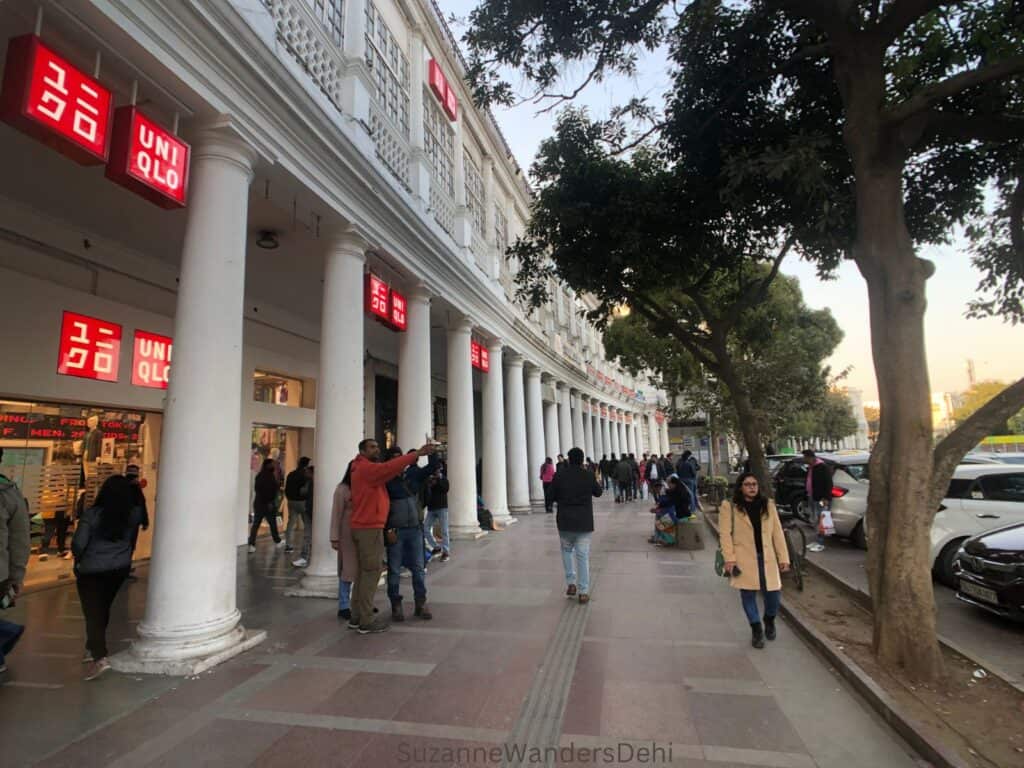
To reach the inner circle of Connaught Place, walk straight up Baba Kharak Singh Road.
Do a little window shopping and people watching in CP while you head to dinner. If you’re feeling adventurous, the lanes of CP have some fabulous street food options and are extremely popular with Delhiites.
There are numerous restaurants in CP. Some favourites are: Naivedyam, Lazeez Affaire CP, Kwality and Zaffran. Unplugged Courtyard has a great terrace with brick oven pizza and live Indian music on weekends.
Where should I stay in Delhi?
No matter what kind of accommodation you book, you should stay in South or Central Delhi. Delhi is a vast city but these two areas are the best – close to many sites, well serviced by metro, safer and popular with expats.
Avoid Old Delhi and Paharganj at all costs. Both are known as backpacker areas, are congested and noisy. There are better budget options in nicer parts of Delhi.
Connaught Place is an excellent area to base yourself in for exploring Delhi, especially if you are a solo traveller or India first timer. It’s very central and a vibrant spot full of shops and restaurants, and a favourite hang out of locals and visitors. There are some wonderful hotels in Connaught Place.
For a luxury stay, my go to favourite is the Imperial, seconded by the Oberoi. At the mid-price point I really like Hotel Palace Heights and the Connaught. Budget options are Bloomrooms @ Janpath, or my all time favourite guest house, Prakash Kutir Bed & Breakfast.
What is the best way to get around Delhi?
The Delhi metro is hands down the best way to move around the city. It’s a modern, easy to use system and goes everywhere. I’m a huge fan of the Delhi metro and use it constantly. It’s cheap, clean, has AC and the first carriage in the moving direction of the train is reserved for females. See my step-by-step guide on how to use the Delhi metro.
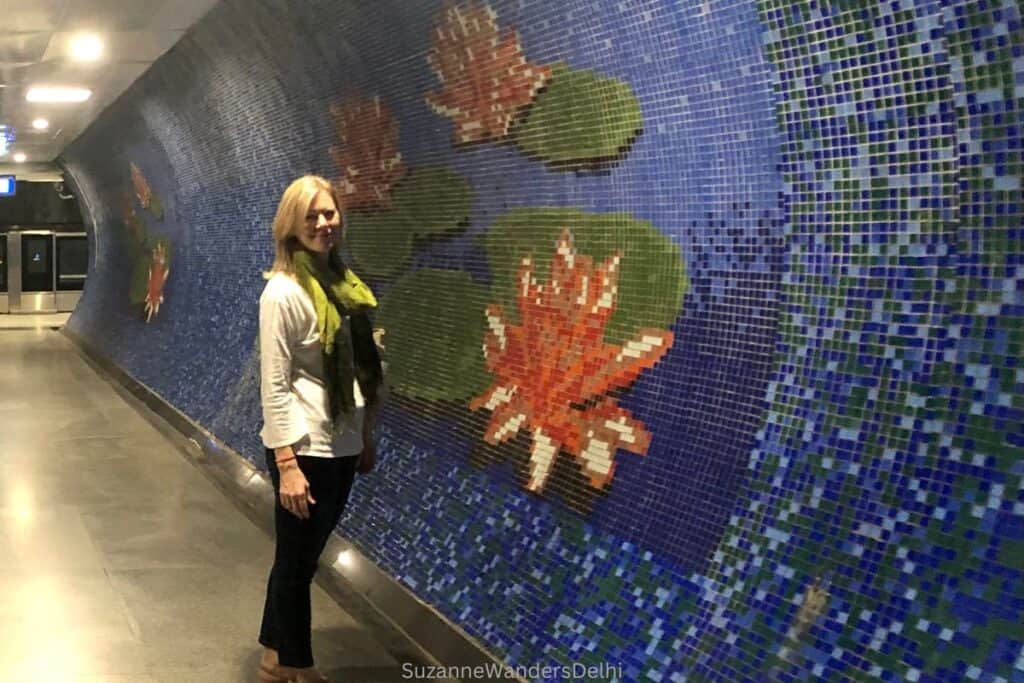
For short distances I take auto rickshaws (tuk tuks). They’re easy to find and perfectly safe during daylight. I also use auto rickshaws to get me to and from metro stations if I don’t feel like walking.
App based taxi services Uber and Ola are also popular. You need local data to access them (you can pick up a local SIM card at the airport on arrival), but they are widely used in Delhi.
If you’re arriving to Delhi by air, here is how to get into Delhi from the Indira Gandhi International Airport.
The Wrap-Up on Delhi Itineraries: How to Spend 5 Epic Days in Delhi
As you can see, there is a lot more to Delhi than meets the eye! If you follow these Delhi itineraries you’ll realize Delhi has a lot to offer, and hopefully agree it is one of the most fascinating cities in the world.
You might also be interested in…
- The Perfect One Day in Delhi: An Insider’s Guide
- Heritage Walk of Old Delhi: An Insider’s DIY Tour
- Old Delhi Street Food Tour: An Insider’s Food Walk
Don’t forget travel insurance! It’s always a good idea to carry travel insurance just in case something goes wrong. I really like and use SafetyWing
